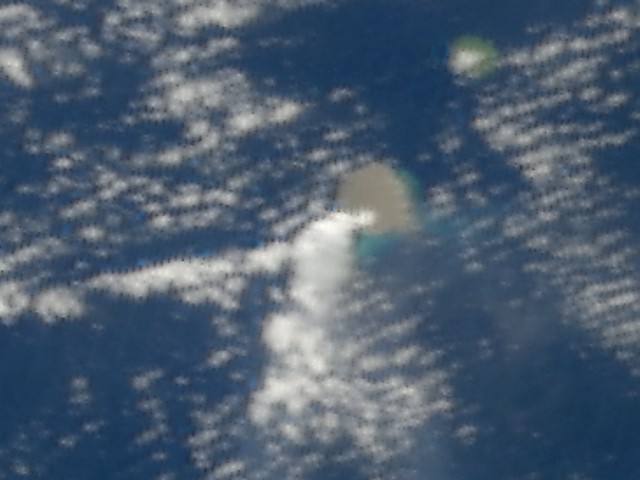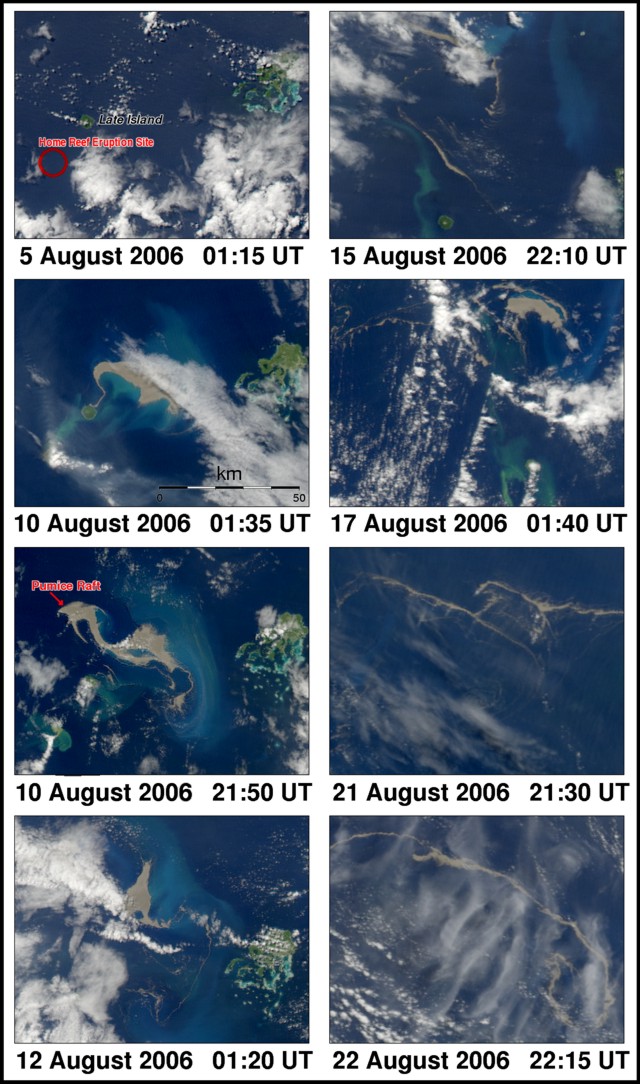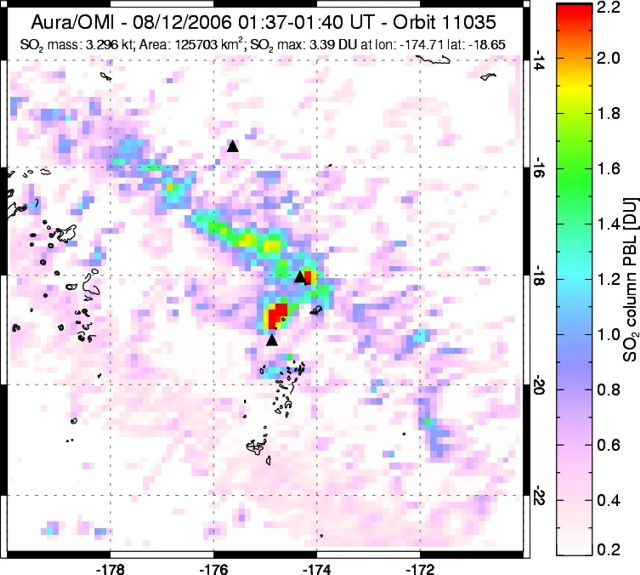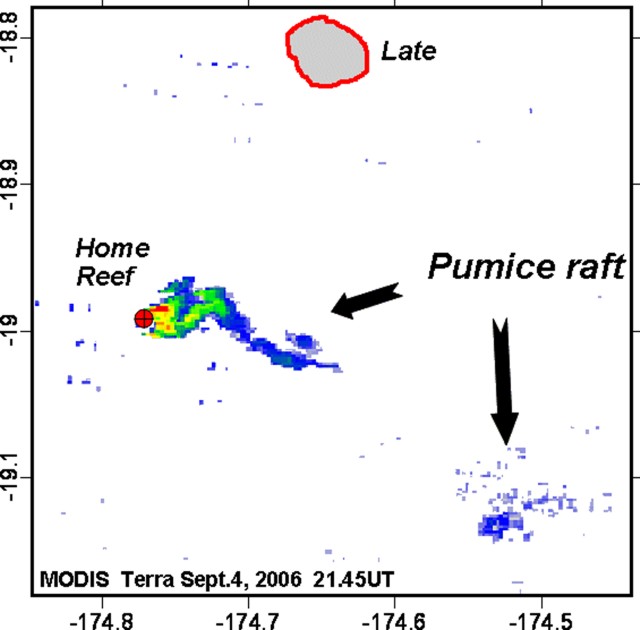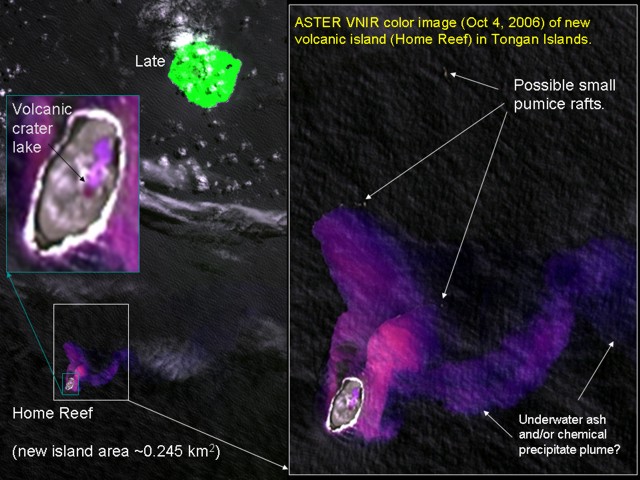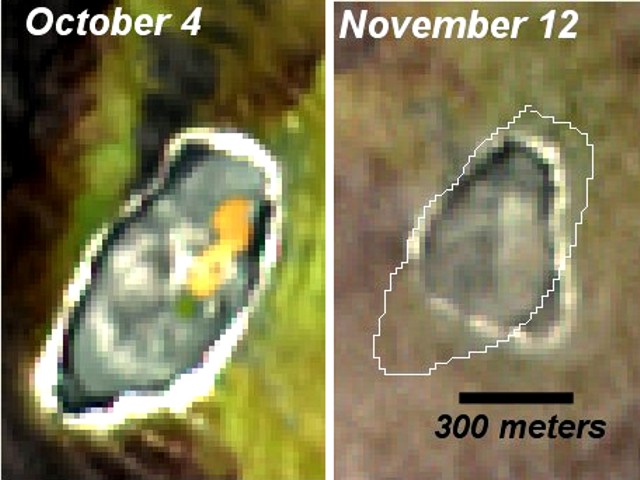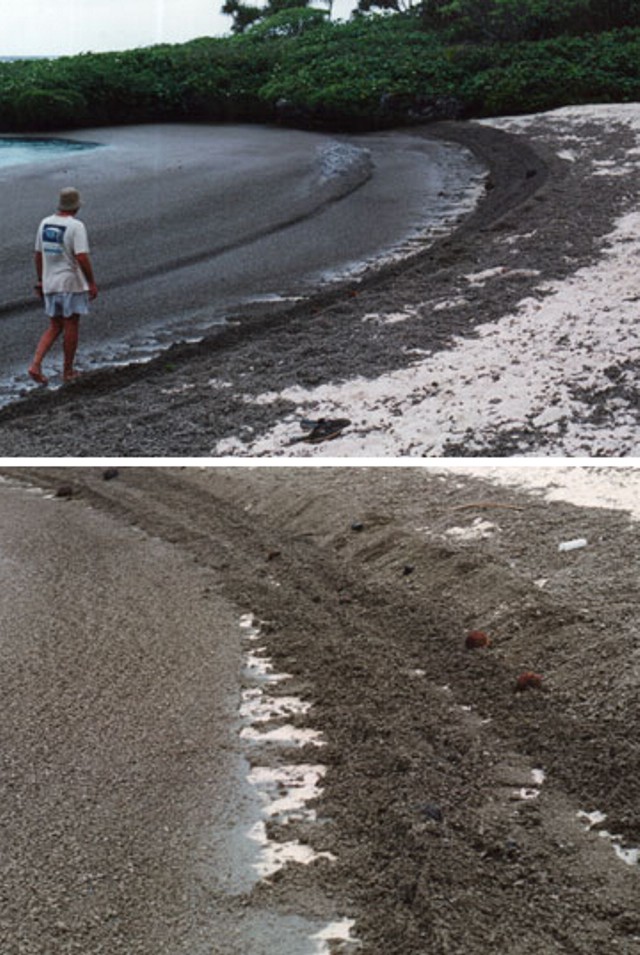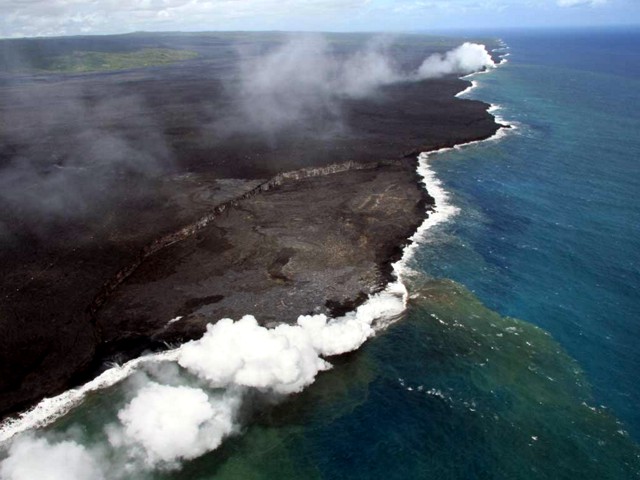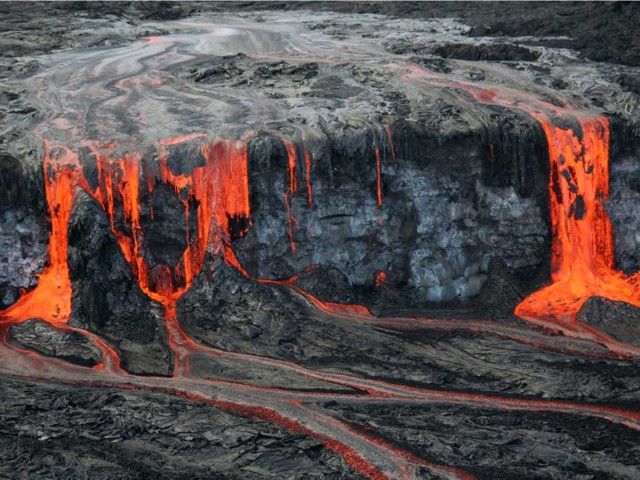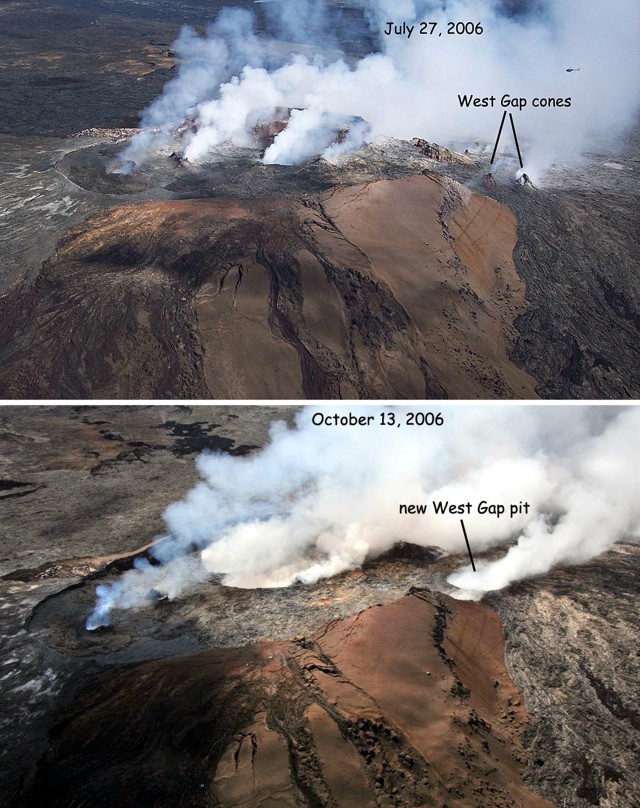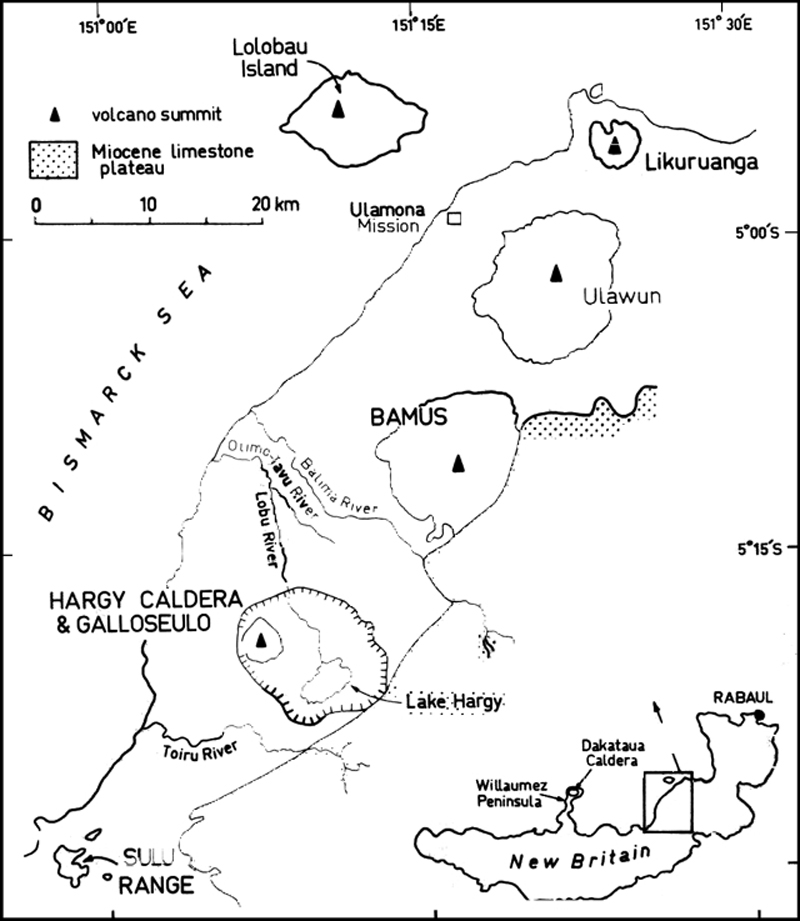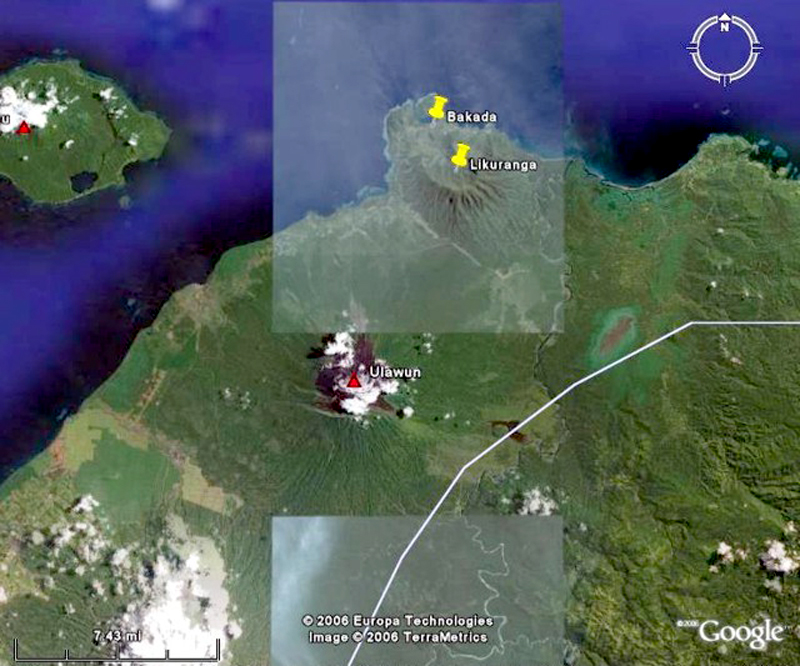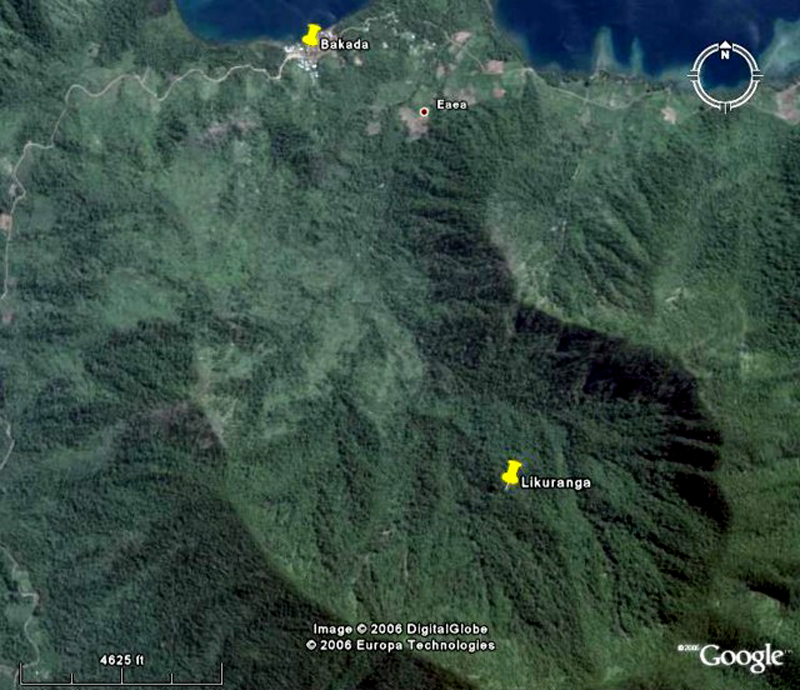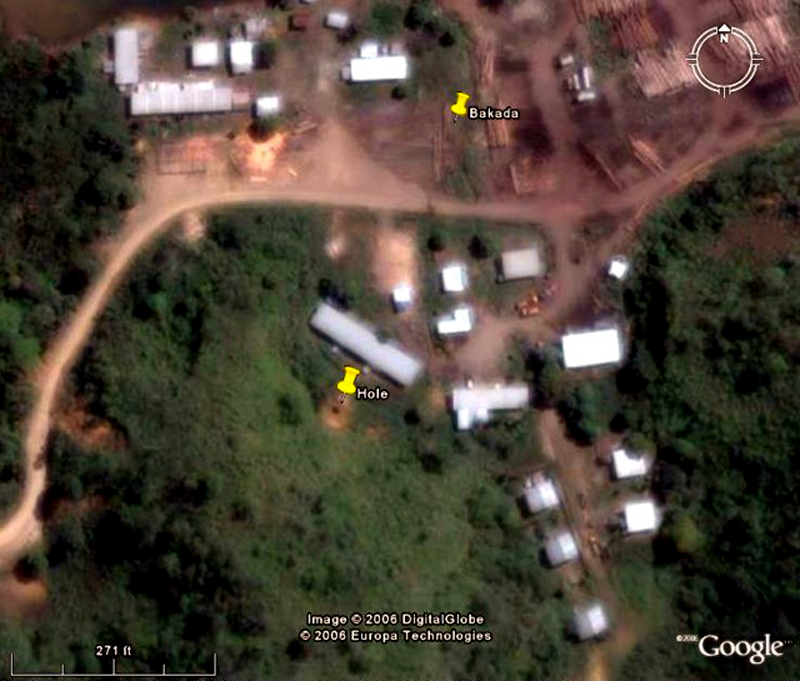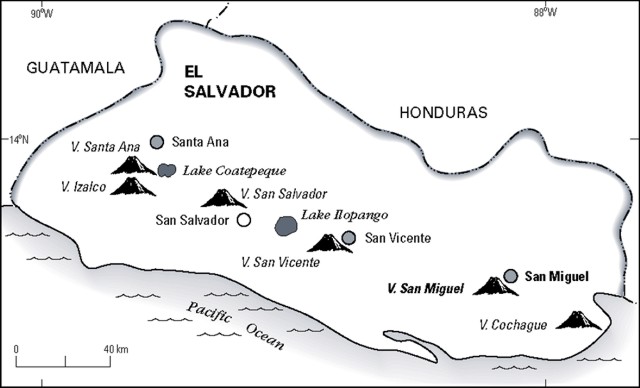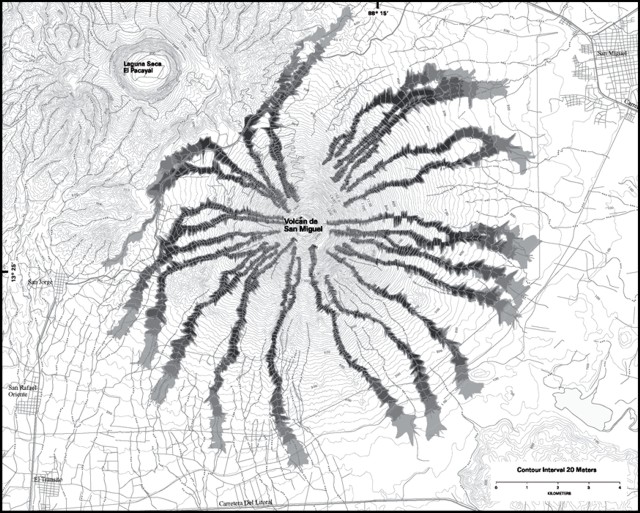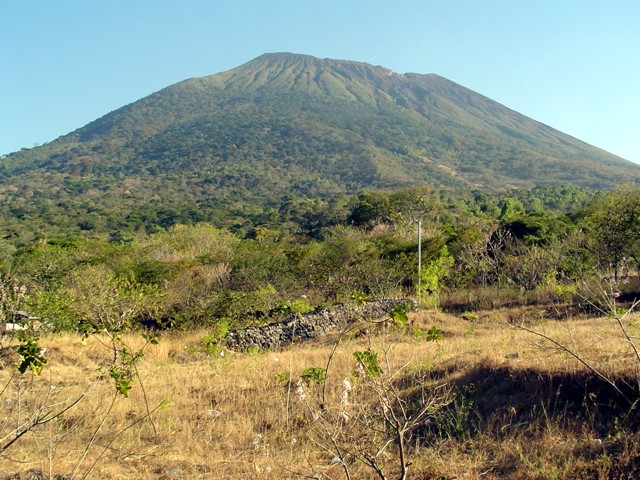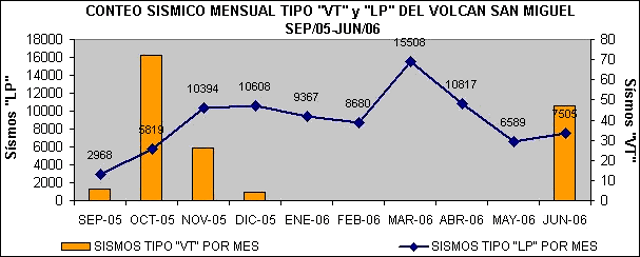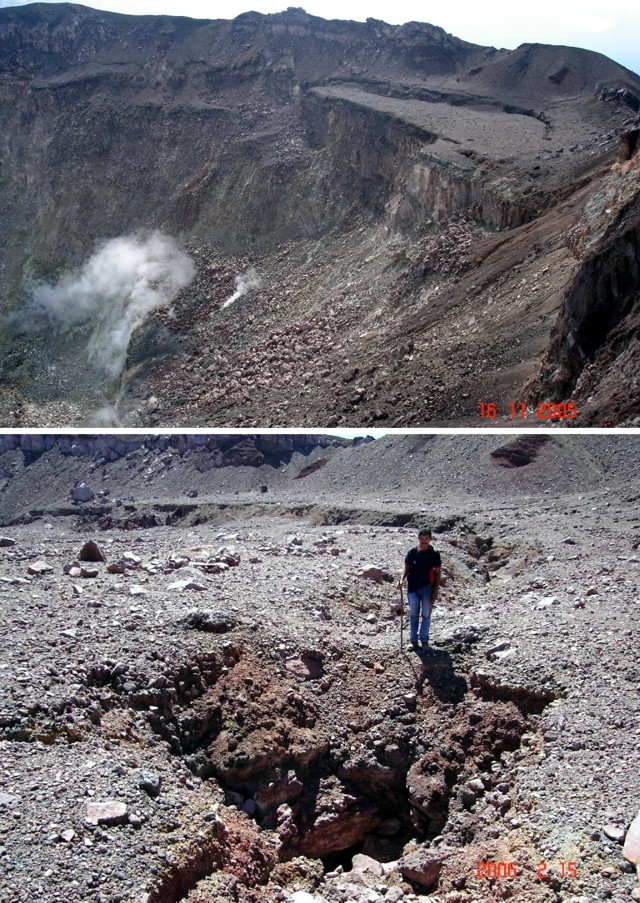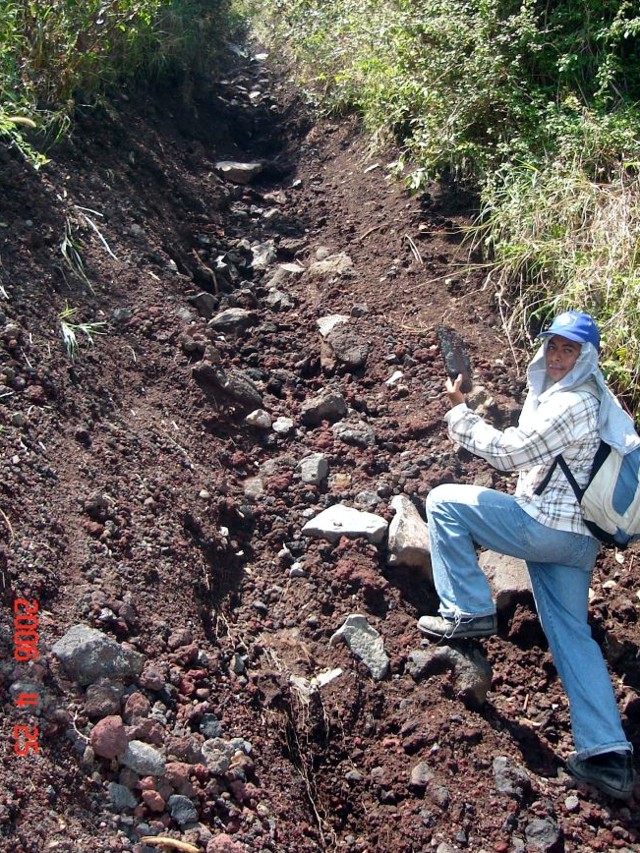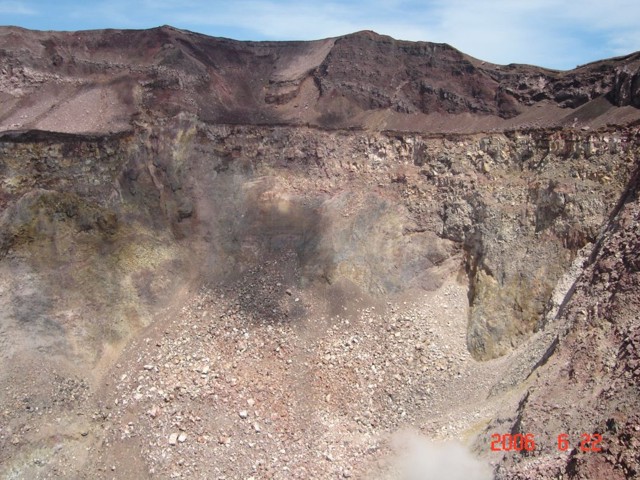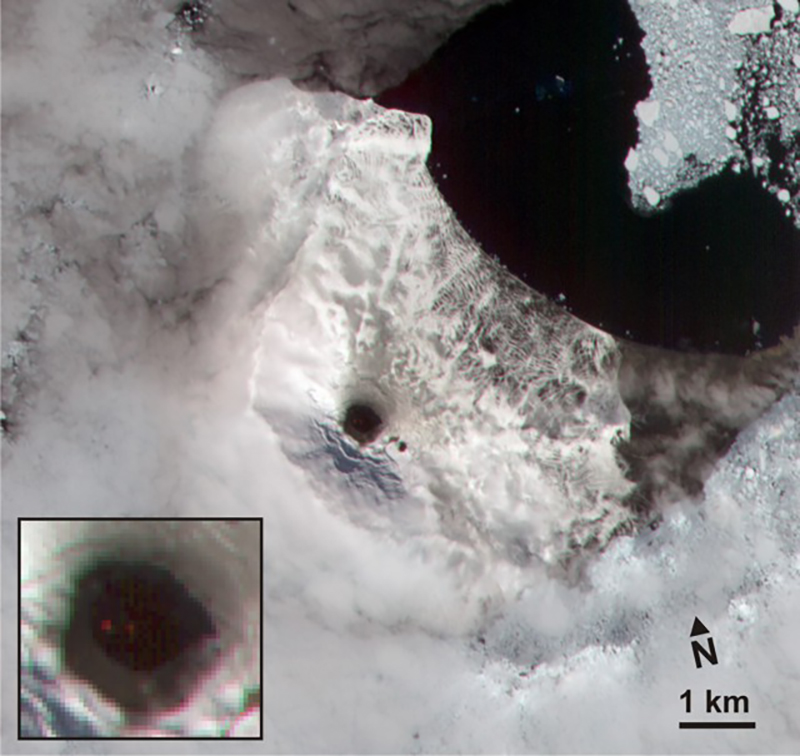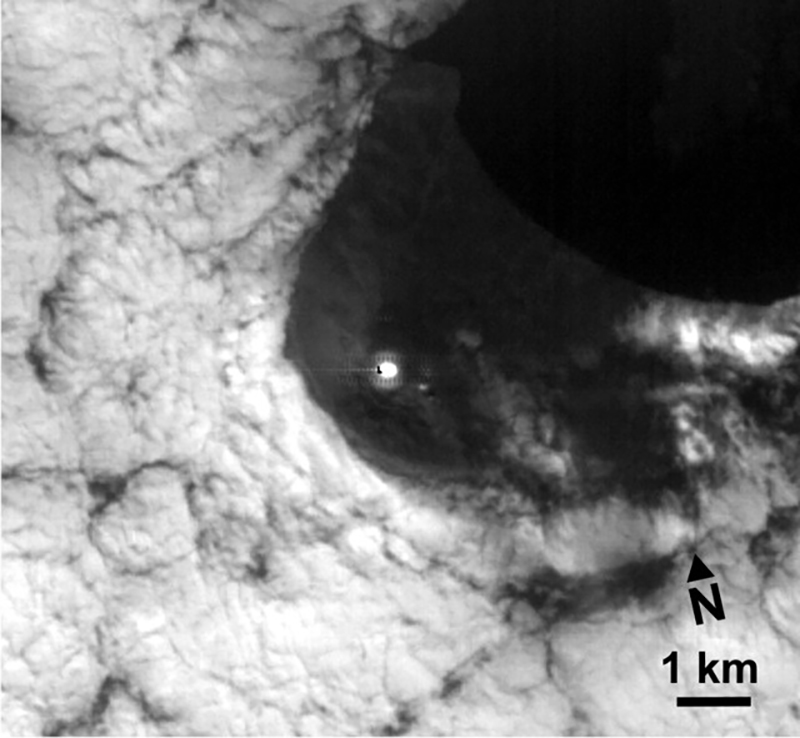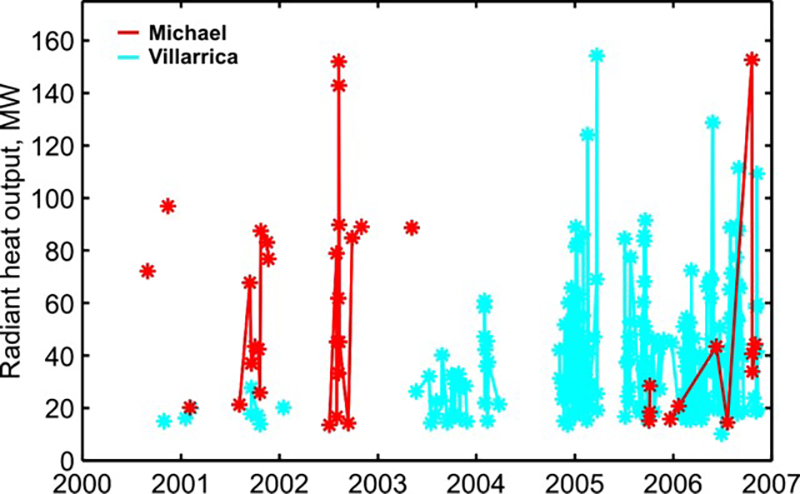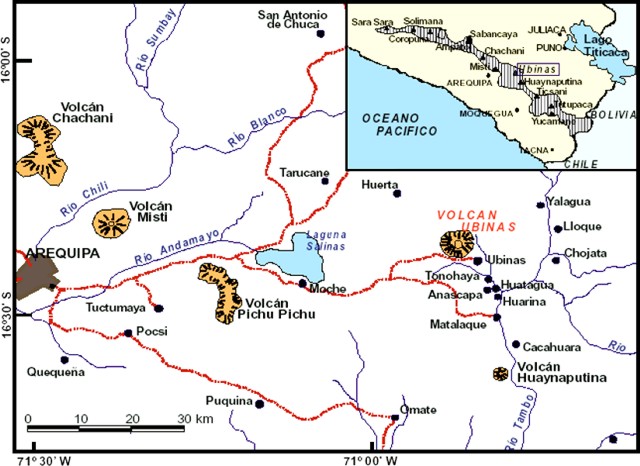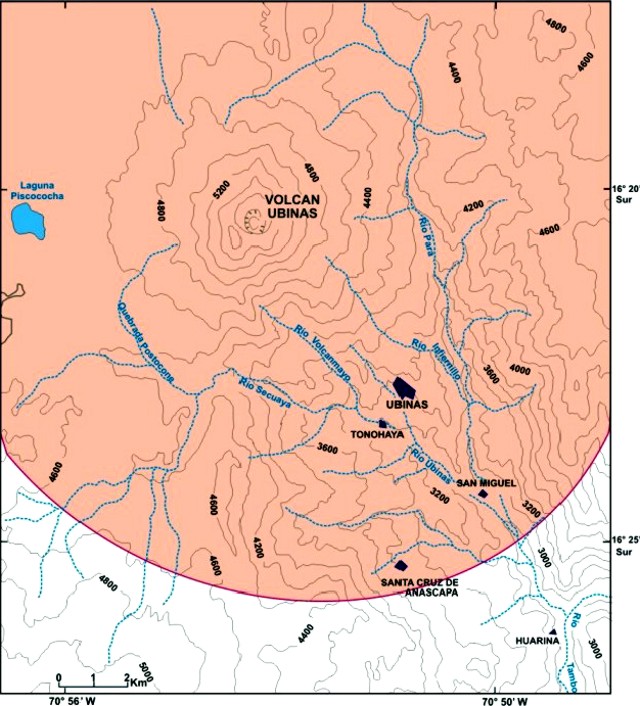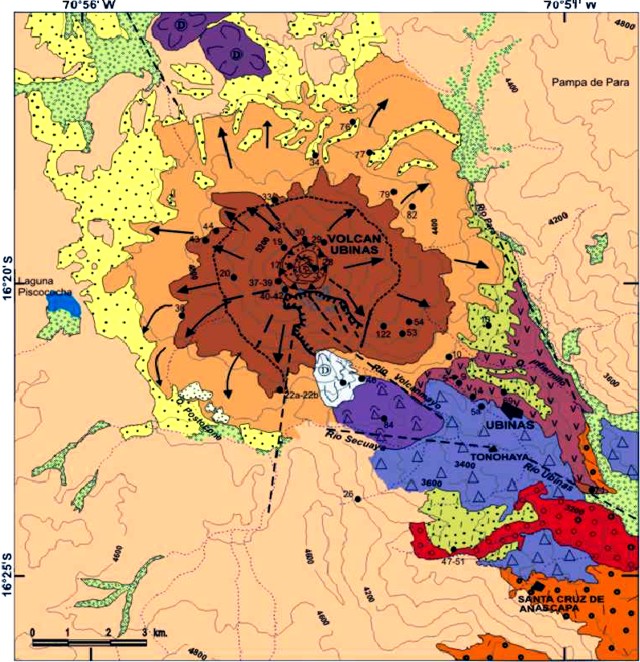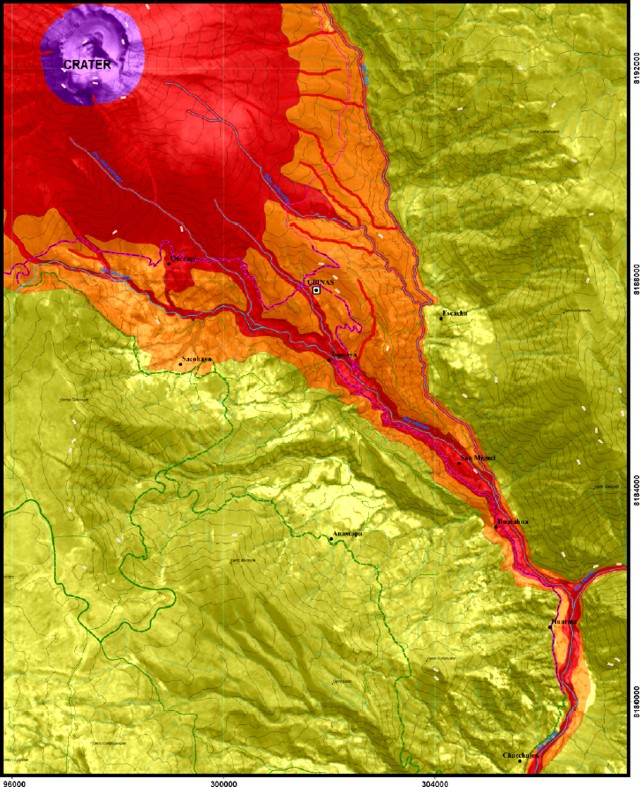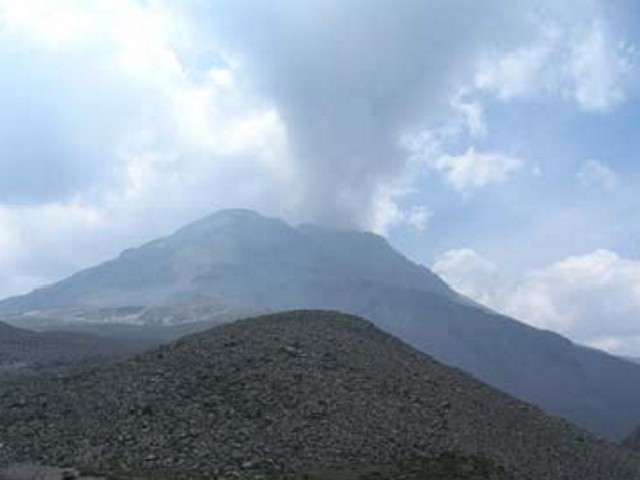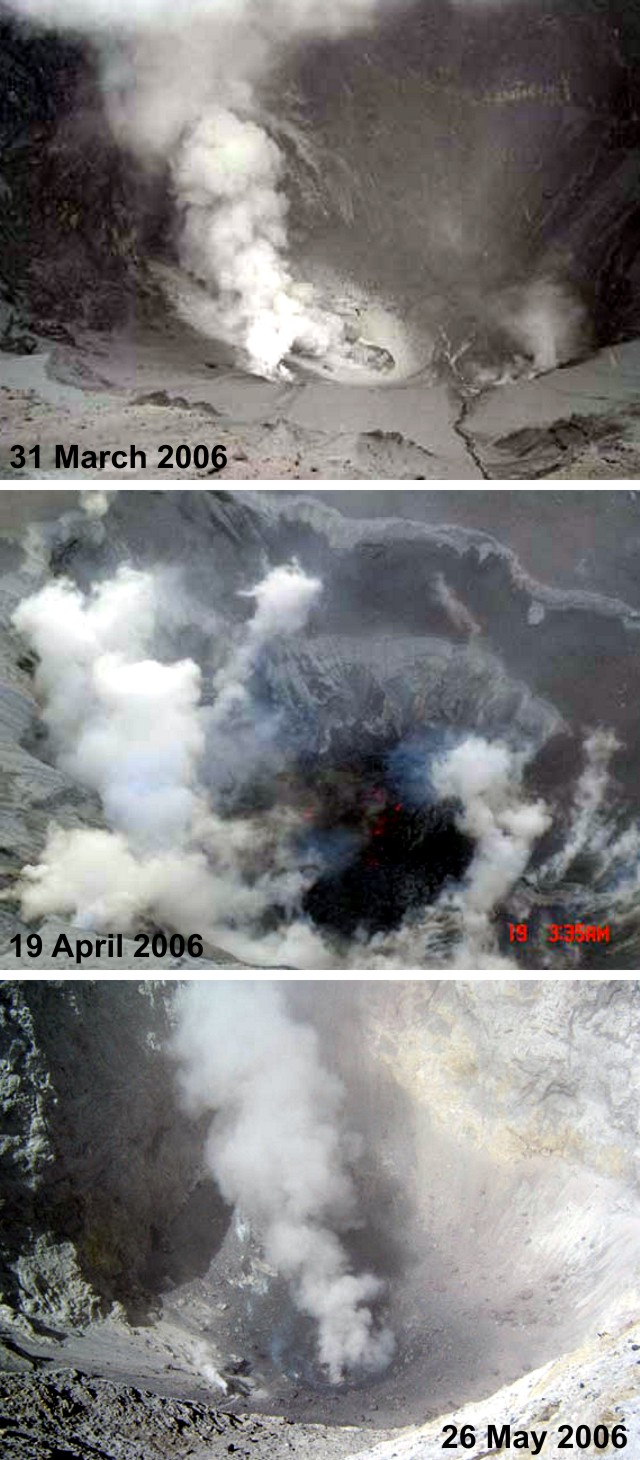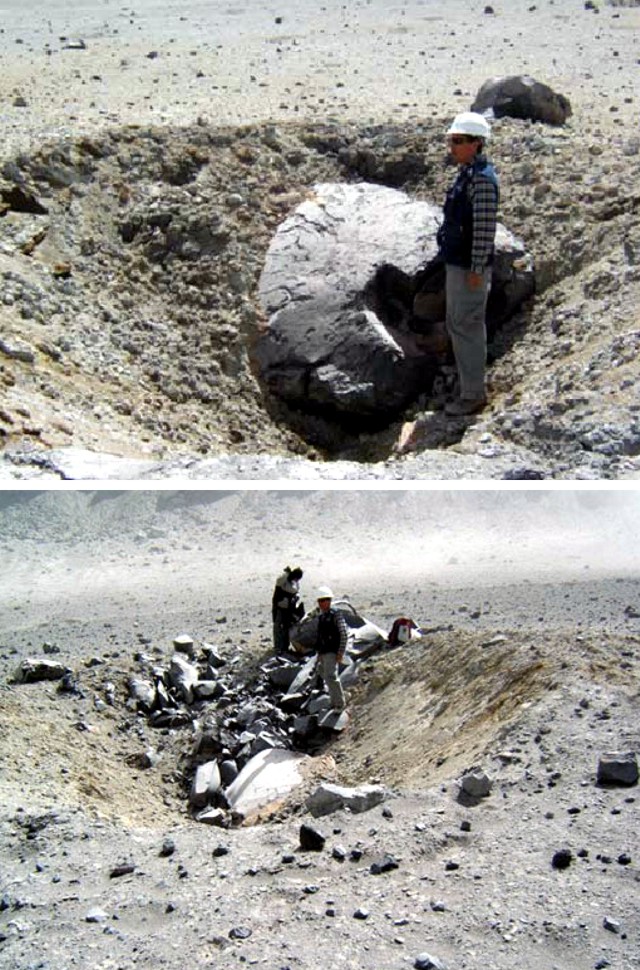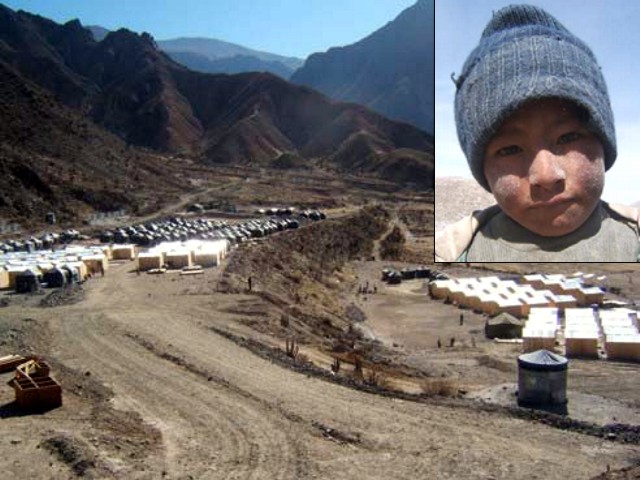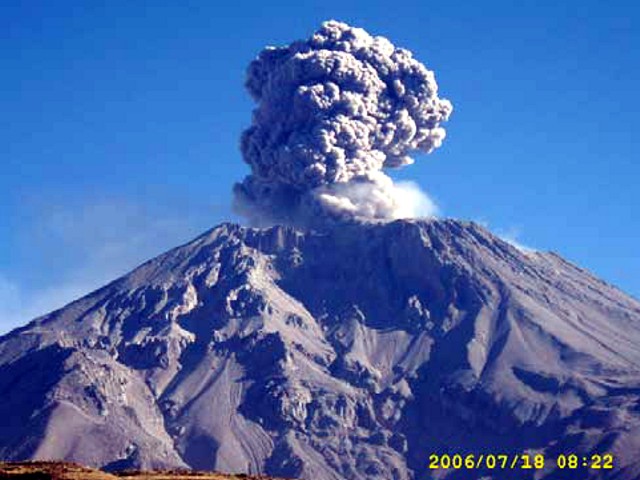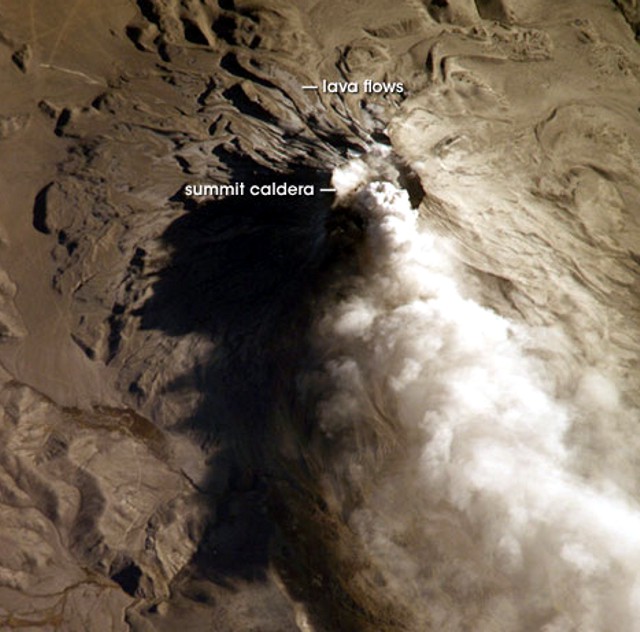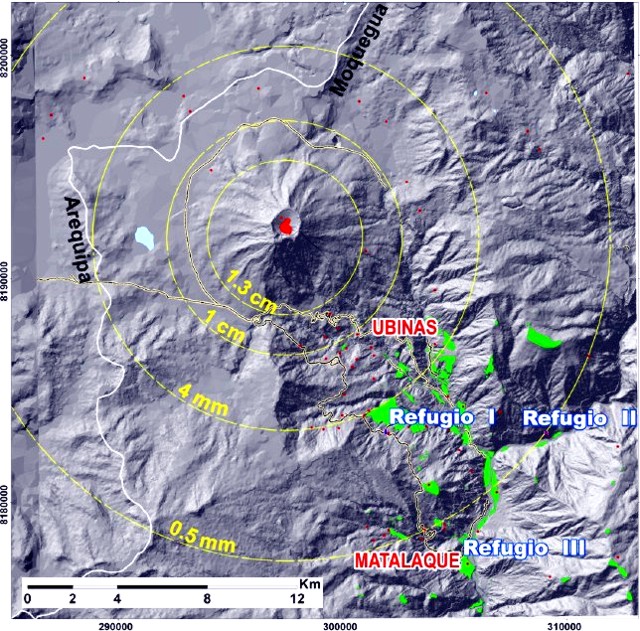Recently Published Bulletin Reports
Erebus (Antarctica) Lava lake remains active; most thermal alerts recorded since 2019
Rincon de la Vieja (Costa Rica) Frequent phreatic explosions during July-December 2023
Bezymianny (Russia) Explosion on 18 October 2023 sends ash plume 8 km high; lava flows and incandescent avalanches
Kilauea (United States) Low-level lava effusions in the lava lake at Halema’uma’u during July-December 2022
Nyamulagira (DR Congo) Lava flows and thermal activity during May-October 2023
Bagana (Papua New Guinea) Explosions, ash plumes, ashfall, and lava flows during April-September 2023
Mayon (Philippines) Lava flows, pyroclastic flows, ash emissions, and seismicity during April-September 2023
Nishinoshima (Japan) Eruption plumes and gas-and-steam plumes during May-August 2023
Krakatau (Indonesia) White gas-and-steam plumes and occasional ash plumes during May-August 2023
Villarrica (Chile) Strombolian activity, gas-and-ash emissions, and crater incandescence during April-September 2023
Merapi (Indonesia) Frequent incandescent avalanches during April-September 2023
Ebeko (Russia) Moderate explosive activity with ash plumes continued during June-November 2023
Erebus (Antarctica) — January 2024  Cite this Report
Cite this Report
Erebus
Antarctica
77.53°S, 167.17°E; summit elev. 3794 m
All times are local (unless otherwise noted)
Lava lake remains active; most thermal alerts recorded since 2019
The lava lake in the summit crater of Erebus has been active since at least 1972. Located in Antarctica overlooking the McMurdo Station on Ross Island, it is the southernmost active volcano on the planet. Because of the remote location, activity is primarily monitored by satellites. This report covers activity during 2023.
The number of thermal alerts recorded by the Hawai'i Institute of Geophysics and Planetology’s MODVOLC Thermal Alerts System increased considerably in 2023 compared to the years 2020-2022 (table 9). In contrast to previous years, the MODIS instruments aboard the Aqua and Terra satellites captured data from Erebus every month during 2023. Consistent with previous years, the lowest number of anomalous pixels were recorded in January, November, and December.
Table 9. Number of monthly MODIS-MODVOLC thermal alert pixels recorded at Erebus during 2017-2023. See BGVN 42:06 for data from 2000 through 2016. The table was compiled using data provided by the HIGP – MODVOLC Thermal Alerts System.
| Year |
Jan |
Feb |
Mar |
Apr |
May |
Jun |
Jul |
Aug |
Sep |
Oct |
Nov |
Dec |
SUM |
| 2017 |
0 |
21 |
9 |
0 |
0 |
1 |
11 |
61 |
76 |
52 |
0 |
3 |
234 |
| 2018 |
0 |
21 |
58 |
182 |
55 |
17 |
137 |
172 |
103 |
29 |
0 |
0 |
774 |
| 2019 |
2 |
21 |
162 |
151 |
55 |
56 |
75 |
53 |
29 |
19 |
1 |
0 |
624 |
| 2020 |
0 |
2 |
16 |
18 |
4 |
4 |
1 |
3 |
18 |
3 |
1 |
6 |
76 |
| 2021 |
0 |
9 |
1 |
0 |
2 |
56 |
46 |
47 |
35 |
52 |
5 |
3 |
256 |
| 2022 |
1 |
13 |
55 |
22 |
15 |
32 |
39 |
19 |
31 |
11 |
0 |
0 |
238 |
| 2023 |
2 |
33 |
49 |
82 |
41 |
32 |
70 |
64 |
42 |
17 |
5 |
11 |
448 |
Sentinel-2 infrared images showed one or two prominent heat sources within the summit crater, accompanied by adjacent smaller sources, similar to recent years (see BGVN 46:01, 47:02, and 48:01). A unique image was obtained on 25 November 2023 by the OLI-2 (Operational Land Imager-2) on Landsat 9, showing the upper part of the volcano surrounded by clouds (figure 32).
Geologic Background. Mount Erebus, the world's southernmost historically active volcano, overlooks the McMurdo research station on Ross Island. It is the largest of three major volcanoes forming the crudely triangular Ross Island. The summit of the dominantly phonolitic volcano has been modified by one or two generations of caldera formation. A summit plateau at about 3,200 m elevation marks the rim of the youngest caldera, which formed during the late-Pleistocene and within which the modern cone was constructed. An elliptical 500 x 600 m wide, 110-m-deep crater truncates the summit and contains an active lava lake within a 250-m-wide, 100-m-deep inner crater; other lava lakes are sometimes present. The glacier-covered volcano was erupting when first sighted by Captain James Ross in 1841. Continuous lava-lake activity with minor explosions, punctuated by occasional larger Strombolian explosions that eject bombs onto the crater rim, has been documented since 1972, but has probably been occurring for much of the volcano's recent history.
Information Contacts: Hawai'i Institute of Geophysics and Planetology (HIGP) - MODVOLC Thermal Alerts System, School of Ocean and Earth Science and Technology (SOEST), Univ. of Hawai'i, 2525 Correa Road, Honolulu, HI 96822, USA (URL: http://modis.higp.hawaii.edu/); Copernicus Browser, Copernicus Data Space Ecosystem, European Space Agency (URL: https://dataspace.copernicus.eu/browser/); NASA Earth Observatory, EOS Project Science Office, NASA Goddard Space Flight Center, Goddard, Maryland, USA (URL: https://earthobservatory.nasa.gov/images/152134/erebus-breaks-through).
Rincon de la Vieja (Costa Rica) — January 2024  Cite this Report
Cite this Report
Rincon de la Vieja
Costa Rica
10.83°N, 85.324°W; summit elev. 1916 m
All times are local (unless otherwise noted)
Frequent phreatic explosions during July-December 2023
Rincón de la Vieja is a volcanic complex in Costa Rica with a hot convecting acid lake that exhibits frequent weak phreatic explosions, gas-and-steam emissions, and occasional elevated sulfur dioxide levels (BGVN 45:10, 46:03, 46:11). The current eruption period began June 2021. This report covers activity during July-December 2023 and is based on weekly bulletins and occasional daily reports from the Observatorio Vulcanologico Sismologica de Costa Rica-Universidad Nacional (OVSICORI-UNA).
Numerous weak phreatic explosions continued during July-December 2023, along with gas-and-steam emissions and plumes that rose as high as 3 km above the crater rim. Many weekly OVSICORI-UNA bulletins included the previous week's number of explosions and emissions (table 9). For many explosions, the time of explosion was given (table 10). Frequent seismic activity (long-period earthquakes, volcano-tectonic earthquakes, and tremor) accompanied the phreatic activity.
Table 9. Number of reported weekly phreatic explosions and gas-and-steam emissions at Rincón de la Vieja, July-December 2023. Counts are reported for the week before the Weekly Bulletin date; not all reports included these data. Courtesy of OVSICORI-UNA.
| OVSICORI Weekly Bulletin |
Number of explosions |
Number of emissions |
| 28 Jul 2023 |
6 |
14 |
| 4 Aug 2023 |
10 |
12 |
| 1 Sep 2023 |
13 |
11 |
| 22 Sep 2023 |
12 |
13 |
| 29 Sep 2023 |
6 |
11 |
| 6 Oct 2023 |
12 |
5 |
| 13 Oct 2023 |
7 |
9 |
| 20 Oct 2023 |
1 |
15 |
| 27 Oct 2023 |
3 |
23 |
| 3 Nov 2023 |
3 |
10 |
| 17 Nov 2023 |
0 |
Some |
| 24 Nov 2023 |
0 |
14 |
| 8 Dec 2023 |
4 |
16 |
| 22 Dec 2023 |
8 |
18 |
Table 10. Summary of activity at Rincón de la Vieja during July-December 2023. Weak phreatic explosions and gas emissions are noted where the time of explosion was indicated in the weekly or daily bulletins. Height of plumes or emissions are distance above the crater rim. Courtesy of OVSICORI-UNA.
| Date |
Time |
Description of Activity |
| 1 Jul 2023 |
0156 |
Explosion. |
| 2 Jul 2023 |
0305 |
Explosion. |
| 4 Jul 2023 |
0229, 0635 |
Event at 0635 produced a gas-and-steam plume that rose 700 m and drifted W; seen by residents in Liberia (21 km SW). |
| 9 Jul 2023 |
1843 |
Explosion. |
| 21 Jul 2023 |
0705 |
Explosion. |
| 26 Jul 2023 |
1807 |
Explosion. |
| 28 Jul 2023 |
0802 |
Explosion generated a gas-and-steam plume that rose 500 m. |
| 30 Jul 2023 |
1250 |
Explosion. |
| 31 Jul 2023 |
2136 |
Explosion. |
| 11 Aug 2023 |
0828 |
Explosion. |
| 18 Aug 2023 |
1304 |
Explosion. |
| 21 Aug 2023 |
1224 |
Explosion generated gas-and-steam plumes rose 500-600 m. |
| 22 Aug 2023 |
0749 |
Explosion generated gas-and-steam plumes rose 500-600 m. |
| 24 Aug 2023 |
1900 |
Explosion. |
| 25 Aug 2023 |
0828 |
Event produced a steam-and-gas plume that rose 3 km and drifted NW. |
| 27-28 Aug 2023 |
0813 |
Four small events; the event at 0813 on 28 August lasted two minutes and generated a steam-and-gas plume that rose 2.5 km. |
| 1 Sep 2023 |
1526 |
Explosion generated plume that rose 2 km and ejected material onto the flanks. |
| 2-3 Sep 2023 |
- |
Small explosions detected in infrasound data. |
| 4 Sep 2023 |
1251 |
Gas-and-steam plume rose 1 km and drifted W. |
| 7 Nov 2023 |
1113 |
Explosion. |
| 8 Nov 2023 |
0722 |
Explosion. |
| 12 Nov 2023 |
0136 |
Small gas emissions. |
| 14 Nov 2023 |
0415 |
Small gas emissions. |
According to OVSICORI-UNA, during July-October the average weekly sulfur dioxide (SO2) flux ranged from 68 to 240 tonnes/day. However, in mid-November the flux increased to as high as 334 tonnes/day, the highest value measured in recent years. The high SO2 flux in mid-November was also detected by the TROPOMI instrument on the Sentinel-5P satellite (figure 43).
Geologic Background. Rincón de la Vieja, the largest volcano in NW Costa Rica, is a remote volcanic complex in the Guanacaste Range. The volcano consists of an elongated, arcuate NW-SE-trending ridge constructed within the 15-km-wide early Pleistocene Guachipelín caldera, whose rim is exposed on the south side. Sometimes known as the "Colossus of Guanacaste," it has an estimated volume of 130 km3 and contains at least nine major eruptive centers. Activity has migrated to the SE, where the youngest-looking craters are located. The twin cone of Santa María volcano, the highest peak of the complex, is located at the eastern end of a smaller, 5-km-wide caldera and has a 500-m-wide crater. A Plinian eruption producing the 0.25 km3 Río Blanca tephra about 3,500 years ago was the last major magmatic eruption. All subsequent eruptions, including numerous historical eruptions possibly dating back to the 16th century, have been from the prominent active crater containing a 500-m-wide acid lake located ENE of Von Seebach crater.
Information Contacts: Observatorio Vulcanológico Sismológica de Costa Rica-Universidad Nacional (OVSICORI-UNA), Apartado 86-3000, Heredia, Costa Rica (URL: http://www.ovsicori.una.ac.cr/); NASA Global Sulfur Dioxide Monitoring Page, Atmospheric Chemistry and Dynamics Laboratory, NASA Goddard Space Flight Center (NASA/GSFC), 8800 Greenbelt Road, Goddard MD 20771, USA (URL: https://so2.gsfc.nasa.gov/).
Bezymianny (Russia) — November 2023  Cite this Report
Cite this Report
Bezymianny
Russia
55.972°N, 160.595°E; summit elev. 2882 m
All times are local (unless otherwise noted)
Explosion on 18 October 2023 sends ash plume 8 km high; lava flows and incandescent avalanches
Bezymianny, located on Russia’s Kamchatka Peninsula, has had eruptions since 1955 characterized by dome growth, explosions, pyroclastic flows, ash plumes, and ashfall. Activity during November 2022-April 2023 included gas-and-steam emissions, lava dome collapses generating avalanches, and persistent thermal activity. Similar eruptive activity continued from May through October 2023, described here based on information from weekly and daily reports of the Kamchatka Volcano Eruptions Response Team (KVERT), notices from Tokyo VAAC (Volcanic Ash Advisory Center), and from satellite data.
Overall activity decreased after the strong period of activity in late March through April 2023, which included ash explosions during 29 March and 7-8 April 2023 that sent plumes as high as 10-12 km altitude, along with dome growth and lava flows (BGVN 48:05). This reduced activity can be seen in the MIROVA thermal detection system graph (figure 56), which was consistent with data from the MODVOLC thermal detection system and with Sentinel-2 satellite images that showed persistent hotspots in the summit crater when conditions allowed observations. A renewed period of strong activity began in mid-October 2023.
Activity increased significantly on 17 October 2023 when large collapses began during 0700-0830 on the E flanks of the lava dome and continued to after 0930 the next day (figure 57). Ash plumes rose to an altitude of 4.5-5 km, extending 220 km NNE by 18 October. A large explosion at 1630 on 18 October produced an ash plume that rose to an altitude of 11 km (8 km above the summit) and drifted NNE and then NW, extending 900 km NW within two days at an altitude of 8 km. Minor ashfall was noted in Kozyrevsk (45 km WNW). At 0820 on 20 October an ash plume was identified in satellite images drifting 100 km ENE at altitudes of 4-4.5 km.
Lava flows and hot avalanches from the dome down the SE flank continued over the next few days, including 23 October when clear conditions allowed good observations (figures 58 and 59). A large thermal anomaly was observed over the volcano through 24 October, and in the summit crater on 30 October (figure 60). Strong fumarolic activity continued, with numerous avalanches and occasional incandescence. By the last week of October, volcanic activity had decreased to a level consistent with that earlier in the reporting period.
Aviation warnings were frequently updated during 17-20 October. KVERT issued a Volcano Observatory Notice for Aviation (VONA) on 17 October at 1419 and 1727 (0219 and 0527 UTC) raising the Aviation Color Code (ACC) from Yellow to Orange (second highest level). The next day, KVERT issued a VONA at 1705 (0505 UTC) raising the ACC to Red (highest level) but lowered it back to Orange at 2117 (0917 UTC). After another decrease to Yellow and back to Orange, the ACC was reduced to Yellow on 20 October at 1204 (0004 UTC). In addition, the Tokyo VAAC issued a series of Volcanic Ash Advisories beginning on 16 October and continuing through 30 October.
Geologic Background. The modern Bezymianny, much smaller than its massive neighbors Kamen and Kliuchevskoi on the Kamchatka Peninsula, was formed about 4,700 years ago over a late-Pleistocene lava-dome complex and an edifice built about 11,000-7,000 years ago. Three periods of intensified activity have occurred during the past 3,000 years. The latest period, which was preceded by a 1,000-year quiescence, began with the dramatic 1955-56 eruption. This eruption, similar to that of St. Helens in 1980, produced a large open crater that was formed by collapse of the summit and an associated lateral blast. Subsequent episodic but ongoing lava-dome growth, accompanied by intermittent explosive activity and pyroclastic flows, has largely filled the 1956 crater.
Information Contacts: Kamchatka Volcanic Eruptions Response Team (KVERT), Far Eastern Branch, Russian Academy of Sciences, 9 Piip Blvd., Petropavlovsk-Kamchatsky, 683006, Russia (URL: http://www.kscnet.ru/ivs/kvert/); Kamchatka Volcanological Station, Kamchatka Branch of Geophysical Survey, (KB GS RAS), Klyuchi, Kamchatka Krai, Russia (URL: http://volkstat.ru/); Tokyo Volcanic Ash Advisory Center (VAAC), 1-3-4 Otemachi, Chiyoda-ku, Tokyo 100-8122, Japan (URL: http://ds.data.jma.go.jp/svd/vaac/data/); Hawai'i Institute of Geophysics and Planetology (HIGP) - MODVOLC Thermal Alerts System, School of Ocean and Earth Science and Technology (SOEST), Univ. of Hawai'i, 2525 Correa Road, Honolulu, HI 96822, USA (URL: http://modis.higp.hawaii.edu/); MIROVA (Middle InfraRed Observation of Volcanic Activity), a collaborative project between the Universities of Turin and Florence (Italy) supported by the Centre for Volcanic Risk of the Italian Civil Protection Department (URL: http://www.mirovaweb.it/); Copernicus Browser, Copernicus Data Space Ecosystem, European Space Agency (URL: https://dataspace.copernicus.eu/browser/).chr
Kilauea (United States) — January 2023  Cite this Report
Cite this Report
Kilauea
United States
19.421°N, 155.287°W; summit elev. 1222 m
All times are local (unless otherwise noted)
Low-level lava effusions in the lava lake at Halema’uma’u during July-December 2022
Kīlauea is the southeastern-most volcano in Hawaii and overlaps the E flank of the Mauna Loa volcano. Its East Rift Zone (ERZ) has been intermittently active for at least 2,000 years. An extended eruption period began in January 1983 and was characterized by open lava lakes and lava flows from the summit caldera and the East Rift Zone. During May 2018 magma migrated into the Lower East Rift Zone (LERZ) and opened 24 fissures along a 6-km-long NE-trending fracture zone that produced lava flows traveling in multiple directions. As lava emerged from the fissures, the lava lake at Halema'uma'u drained and explosions sent ash plumes to several kilometers altitude (BGVN 43:10).
The current eruption period started during September 2021 and has recently been characterized by lava effusions, spatter, and sulfur dioxide emissions in the active Halema’uma’u lava lake (BGVN 47:08). Lava effusions, some spatter, and sulfur dioxide emissions have continued during this reporting period of July through December 2022 using daily reports, volcanic activity notices, and abundant photo, map, and video data from the US Geological Survey's (USGS) Hawaiian Volcano Observatory (HVO).
Summary of activity during July-December 2022. Low-level effusions have continued at the western vent of the Halema’uma’u crater during July through early December 2022. Occasional weak ooze-outs (also called lava break outs) would occur along the margins of the crater floor. The overall level of the active lava lake throughout the reporting period gradually increased due to infilling, however it stagnated in mid-September (table 13). During September through November, activity began to decline, though lava effusions persisted at the western vent. By 9 December, the active part of the lava lake had completely crusted over, and incandescence was no longer visible.
Table 13. Summary of measurements taken during overflights at Kīlauea that show a gradual increase in the active lava lake level and the volume of lava effused since 29 September 2021. Lower activity was reported during September-October. Data collected during July-December 2022. Courtesy of HVO.
| Date: |
Level of the active lava lake (m): |
Cumulative volume of lava effused (million cubic meters): |
| 7 Jul 2022 |
130 |
95 |
| 19 Jul 2022 |
133 |
98 |
| 4 Aug 2022 |
136 |
102 |
| 16 Aug 2022 |
137 |
104 |
| 12 Sep 2022 |
143 |
111 |
| 5 Oct 2022 |
143 |
111 |
| 28 Oct 2022 |
143 |
111 |
Activity during July 2022. Lava effusions were reported from the western vent in the Halema’uma’u crater, along with occasional weak ooze-outs along the margins of the crater floor. The height of the lava lake was variable due to deflation-inflation tilt events; for example, the lake level dropped approximately 3-4 m during a summit deflation-inflation event reported on 1 July. Webcam images taken during the night of 6-12 July showed intermittent low-level spattering at the western vent that rose less than 10 m above the vent (figure 519). Measurements made during an overflight on 7 July indicated that the crater floor was infilled about 130 m and that 95 million cubic meters of lava had been effused since 29 September 2021. A single, relatively small lava ooze-out was active to the S of the lava lake. Around midnight on 8 July there were two brief periods of lava overflow onto the lake margins. On 9 July lava ooze-outs were reported near the SE and NE edges of the crater floor and during 10-11 July they occurred near the E, NE, and NW edges. On 16 July crater incandescence was reported, though the ooze-outs and spattering were not visible. On 18 July overnight webcam images showed incandescence in the western vent complex and two ooze-outs were reported around 0000 and 0200 on 19 July. By 0900 there were active ooze-outs along the SW edge of the crater floor. Measurements made from an overflight on 19 July indicated that the crater floor was infilled about 133 m and 98 million cubic meters of lava had erupted since 29 September 2021 (figure 520). On 20 July around 1600 active ooze-outs were visible along the N edge of the crater, which continued through the next day. Extensive ooze-outs occurred along the W margin during 24 July until 1900; on 26 July minor ooze-outs were noted along the N margin. Minor spattering was visible on 29 July along the E margin of the lake. The sulfur dioxide emission rates ranged 650-2,800 tons per day (t/d), the higher of which was measured on 8 July (figure 519).
Activity during August 2022. The eruption continued in the Halema’uma’u crater at the western vent. According to HVO the lava in the active lake remained at the level of the bounding levees. Occasional minor ooze-outs were observed along the margins of the crater floor. Strong nighttime crater incandescence was visible after midnight on 6 August over the western vent cone. During 6-7 August scattered small lava lobes were active along the crater floor and incandescence persisted above the western vent through 9 August. During 7-9 August HVO reported a single lava effusion source was active along the NW margin of the crater floor. Measurements from an overflight on 4 August indicated that the crater floor was infilled about 136 m total and that 102 million cubic meters of lava had been erupted since the start of the eruption. Lava breakouts were reported along the N, NE, E, S, and W margins of the crater during 10-16 August. Another overflight survey conducted on 16 August indicated that the crater floor infilled about 137 m and 104 million cubic meters of lava had been erupted since September 2021. Measured sulfur dioxide emissions rates ranged 1,150-2,450 t/d, the higher of which occurred on 8 August.
Activity during September 2022. During September, lava effusion continued from the western vent into the active lava lake and onto the crater floor. Intermittent minor ooze-outs were reported through the month. A small ooze-out was visible on the W crater floor margin at 0220 on 2 September, which showed decreasing surface activity throughout the day, but remained active through 3 September. On 3 September around 1900 a lava outbreak occurred along the NW margin of the crater floor but had stopped by the evening of 4 September. Field crews monitoring the summit lava lake on 9 September observed spattering on the NE margin of the lake that rose no higher than 10 m, before falling back onto the lava lake crust (figure 521). Overflight measurements on 12 September indicated that the crater floor was infilled a total of 143 m and 111 million cubic meters of lava had been erupted since September 2021. Extensive breakouts in the W and N part of the crater floor were reported at 1600 on 20 September and continued into 26 September. The active part of the lava lake dropped by 10 m while other parts of the crater floor dropped by several meters. Summit tiltmeters recorded a summit seismic swarm of more than 80 earthquakes during 1500-1800 on 21 September, which occurred about 1.5 km below Halema’uma’u; a majority of these were less than Mw 2. By 22 September the active part of the lava lake was infilled about 2 m. On 23 September the western vent areas exhibited several small spatter cones with incandescent openings, along with weak, sporadic spattering (figure 522). The sulfur dioxide emission rate ranged from 930 t/d to 2,000 t/d, the higher of which was measured on 6 September.
Activity during October 2022. Activity during October declined slightly compared to previous months, though lava effusions persisted from the western vent into the active lava lake and onto the crater floor during October (figure 523). Slight variations in the lava lake were noted throughout the month. HVO reported that around 0600 on 3 October the level of the lava lake has lowered slightly. Overflight measurements taken on 5 October indicated that the crater floor was infilled a total of about 143 m and that 111 million cubic meters of lava had been effused since September 2021. During 6-7 October the lake gradually rose 0.5 m. Sulfur dioxide measurements made on 22 October had an emission rate of 700 t/d. Another overflight taken on 28 October showed that there was little to no change in the elevation of the crater floor: the crater floor was infilled a total of 143 m and 111 million cubic meters of lava had erupted since the start of the eruption.
Activity during November 2022. Activity remained low during November, though HVO reported that lava from the western vent continued to effuse into the active lava lake and onto the crater floor throughout the month. The rate of sulfur dioxide emissions during November ranged from 300-600 t/d, the higher amount of which occurred on 9 November.
Activity during December 2022. Similar low activity was reported during December, with lava effusing from the western vent into the active lava lake and onto the crater floor. During 4-5 December the active part of the lava lake was slightly variable in elevation and fluctuated within 1 m. On 9 December HVO reported that lava was no longer erupting from the western vent in the Halema’uma’u crater and that sulfur dioxide emissions had returned to near pre-eruption background levels; during 10-11 December, the lava lake had completely crusted over, and no incandescence was visible (figure 524). Time lapse camera images covering the 4-10 December showed that the crater floor showed weak deflation and no inflation. Some passive events of crustal overturning were reported during 14-15 December, which brought fresh incandescent lava to the lake surface. The sulfur dioxide emission rate was approximately 200 t/d on 14 December. A smaller overturn event on 17 December and another that occurred around 0000 and into the morning of 20 December were also detected. A small seismic swarm was later detected on 30 December.
Geologic Background. Kilauea overlaps the E flank of the massive Mauna Loa shield volcano in the island of Hawaii. Eruptions are prominent in Polynesian legends; written documentation since 1820 records frequent summit and flank lava flow eruptions interspersed with periods of long-term lava lake activity at Halemaumau crater in the summit caldera until 1924. The 3 x 5 km caldera was formed in several stages about 1,500 years ago and during the 18th century; eruptions have also originated from the lengthy East and Southwest rift zones, which extend to the ocean in both directions. About 90% of the surface of the basaltic shield volcano is formed of lava flows less than about 1,100 years old; 70% of the surface is younger than 600 years. The long-term eruption from the East rift zone between 1983 and 2018 produced lava flows covering more than 100 km2, destroyed hundreds of houses, and added new coastline.
Information Contacts: Hawaiian Volcano Observatory (HVO), U.S. Geological Survey, PO Box 51, Hawai'i National Park, HI 96718, USA (URL: http://hvo.wr.usgs.gov/).
Nyamulagira (DR Congo) — November 2023  Cite this Report
Cite this Report
Nyamulagira
DR Congo
1.408°S, 29.2°E; summit elev. 3058 m
All times are local (unless otherwise noted)
Lava flows and thermal activity during May-October 2023
Nyamulagira (also known as Nyamuragira) is a shield volcano in the Democratic Republic of Congo with the summit truncated by a small 2 x 2.3 km caldera with walls up to about 100 m high. Documented eruptions have occurred within the summit caldera, as well as from numerous flank fissures and cinder cones. The current eruption period began in April 2018 and has more recently been characterized by summit crater lava flows and thermal activity (BGVN 48:05). This report describes lava flows and variable thermal activity during May through October 2023, based on information from the Observatoire Volcanologique de Goma (OVG) and various satellite data.
Lava lake activity continued during May. The MIROVA (Middle InfraRed Observation of Volcanic Activity) system recorded moderate-to-strong thermal activity throughout the reporting period; activity was more intense during May and October and relatively weaker from June through September (figure 95). The MODVOLC thermal algorithm, detected a total of 209 thermal alerts. There were 143 hotspots detected during May, eight during June, nine during September, and 49 during October. This activity was also reflected in infrared satellite images, where a lava flow was visible in the NW part of the crater on 7 May and strong activity was seen in the center of the crater on 4 October (figure 96). Another infrared satellite image taken on 12 May showed still active lava flows along the NW margin of the crater. According to OVG lava effusions were active during 7-29 May and moved to the N and NW parts of the crater beginning on 9 May. Strong summit crater incandescence was visible from Goma (27 km S) during the nights of 17, 19, and 20 May (figure 97). On 17 May there was an increase in eruptive activity, which peaked at 0100 on 20 May. Notable sulfur dioxide plumes drifted NW and W during 19-20 May (figure 98). Drone footage acquired in partnership with the USGS (United States Geological Survey) on 20 May captured images of narrow lava flows that traveled about 100 m down the W flank (figure 99). Data from the Rumangabo seismic station indicated a decreasing trend in activity during 17-21 May. Although weather clouds prevented clear views of the summit, a strong thermal signature on the NW flank was visible in an infrared satellite image on 22 May, based on an infrared satellite image. On 28 May the lava flows on the upper W flank began to cool and solidify. By 29 May seismicity returned to levels similar to those recorded before the 17 May increase. Lava effusion continued but was confined to the summit crater; periodic crater incandescence was observed.
Low-level activity was noted during June through October. On 1 June OVG reported that seismicity remained at lower levels and that crater incandescence had been absent for three days, though infrared satellite imagery showed continued lava effusion in the summit crater. The lava flows on the flanks covered an estimated 0.6 km2. Satellite imagery continued to show thermal activity confined to the lava lake through October (figure 96), although no lava flows or significant sulfur dioxide emissions were reported.
Geologic Background. Africa's most active volcano, Nyamulagira (also known as Nyamuragira), is a massive high-potassium basaltic shield about 25 km N of Lake Kivu and 13 km NNW of the steep-sided Nyiragongo volcano. The summit is truncated by a small 2 x 2.3 km caldera that has walls up to about 100 m high. Documented eruptions have occurred within the summit caldera, as well as from the numerous flank fissures and cinder cones. A lava lake in the summit crater, active since at least 1921, drained in 1938, at the time of a major flank eruption. Recent lava flows extend down the flanks more than 30 km from the summit as far as Lake Kivu; extensive lava flows from this volcano have covered 1,500 km2 of the western branch of the East African Rift.
Information Contacts: Observatoire Volcanologique de Goma (OVG), Departement de Geophysique, Centre de Recherche en Sciences Naturelles, Lwiro, D.S. Bukavu, DR Congo; Hawai'i Institute of Geophysics and Planetology (HIGP) - MODVOLC Thermal Alerts System, School of Ocean and Earth Science and Technology (SOEST), Univ. of Hawai'i, 2525 Correa Road, Honolulu, HI 96822, USA (URL: http://modis.higp.hawaii.edu/); MIROVA (Middle InfraRed Observation of Volcanic Activity), a collaborative project between the Universities of Turin and Florence (Italy) supported by the Centre for Volcanic Risk of the Italian Civil Protection Department (URL: http://www.mirovaweb.it/); NASA Global Sulfur Dioxide Monitoring Page, Atmospheric Chemistry and Dynamics Laboratory, NASA Goddard Space Flight Center (NASA/GSFC), 8800 Greenbelt Road, Goddard, Maryland, USA (URL: https://so2.gsfc.nasa.gov/); Copernicus Browser, Copernicus Data Space Ecosystem, European Space Agency (URL: https://dataspace.copernicus.eu/browser/); Charles Balagizi, Goma Volcano Observatory, Departement de Geophysique, Centre de Recherche en Sciences Naturelles, Lwiro, D.S. Bukavu, DR Congo.
Bagana (Papua New Guinea) — October 2023  Cite this Report
Cite this Report
Bagana
Papua New Guinea
6.137°S, 155.196°E; summit elev. 1855 m
All times are local (unless otherwise noted)
Explosions, ash plumes, ashfall, and lava flows during April-September 2023
The remote volcano of Bagana is located in central Bougainville Island, Papua New Guinea. Recorded eruptions date back to 1842 and activity has consisted of effusive activity that has built a small lava dome in the summit crater and occasional explosions that produced pyroclastic flows. The most recent eruption has been ongoing since February 2000 and has produced occasional explosions, ash plumes, and lava flows. More recently, activity has been characterized by ongoing effusive activity and ash emissions (BGVN 48:04). This report updates activity from April through September 2023 that has consisted of explosions, ash plumes, ashfall, and lava flows, using information from the Darwin Volcanic Ash Advisory Center (VAAC) and satellite data.
An explosive eruption was reported on 7 July that generated a large gas-and-ash plume to high altitudes and caused significant ashfall in local communities; the eruption plume had reached upper tropospheric (16-18 km altitude) altitudes by 2200, according to satellite images. Sulfur dioxide plumes were detected in satellite images on 8 July and indicated that the plume was likely a mixture of gas, ice, and ash. A report issued by the Autonomous Bougainville Government (ABG) (Torokina District, Education Section) on 10 July noted that significant ash began falling during 2000-2100 on 7 July and covered most areas in the Vuakovi, Gotana (9 km SW), Koromaketo, Laruma (25 km W) and Atsilima (27 km NW) villages. Pyroclastic flows also occurred, according to ground-based reports; small deposits confined to one drainage were inspected by RVO during an overflight on 17 July and were confirmed to be from the 7 July event. Ashfall continued until 10 July and covered vegetation, which destroyed bushes and gardens and contaminated rivers and streams.
RVO reported another eruption on 14 July. The Darwin VAAC stated that an explosive event started around 0830 on 15 July and produced an ash plume that rose to 16.5 km altitude by 1000 and drifted N, according to satellite images. The plume continued to drift N and remained visible through 1900, and by 2150 it had dissipated.
Ashfall likely from both the 7 and 15 July events impacted about 8,111 people in Torokina (20 km SW), including Tsito/Vuakovi, Gotana, Koromaketo, Kenaia, Longkogari, Kenbaki, Piva (13 km SW), and Atsinima, and in the Tsitovi district, according to ABG. Significant ashfall was also reported in Ruruvu (22 km N) in the Wakunai District of Central Bougainville, though the thickness of these deposits could not be confirmed. An evacuation was called for the villages in Wakunai, where heavy ashfall had contaminated water sources; the communities of Ruruvu, Togarau, Kakarapaia, Karauturi, Atao, and Kuritaturi were asked to evacuate to a disaster center at the Wakunai District Station, and communities in Torokina were asked to evacuate to the Piva District station. According to a news article, more than 7,000 people needed temporary accommodations, with about 1,000 people in evacuation shelters. Ashfall had deposited over a broad area, contaminating water supplies, affecting crops, and collapsing some roofs and houses in rural areas. Schools were temporarily shut down. Intermittent ash emissions continued through the end of July and drifted NNW, NW, and SW. Fine ashfall was reported on the coast of Torokina, and ash plumes also drifted toward Laruma and Atsilima.
A small explosive eruption occurred at 2130 on 28 July that ejected material from the crater vents, according to reports from Torokina, in addition to a lava flow that contained two lobes. A second explosion was detected at 2157. Incandescence from the lava flow was visible from Piva as it descended the W flank around 2000 on 29 July (figure 47). The Darwin VAAC reported that a strong thermal anomaly was visible in satellite images during 30-31 July and that ash emissions rose to 2.4 km altitude and drifted WSW on 30 July. A ground report from RVO described localized emissions at 0900 on 31 July.
The Darwin VAAC reported that ash plumes were identified in satellite imagery at 0800 and 1220 on 12 August and rose to 2.1 km and 3 km altitude and drifted NW and W, respectively. A news report stated that aid was sent to more than 6,300 people that were adversely affected by the eruption. Photos taken during 17-19 August showed ash emissions rising no higher than 1 km above the summit and drifting SE. A small explosion generated an ash plume during the morning of 19 August. Deposits from small pyroclastic flows were also captured in the photos. Satellite images captured lava flows and pyroclastic flow deposits. Two temporary seismic stations were installed near Bagana on 17 August at distances of 7 km WSW (Vakovi station) and 11 km SW (Kepox station). The Kepox station immediately started to record continuous, low-frequency background seismicity.
Satellite data. Little to no thermal activity was detected during April through mid-July 2023; only one anomaly was recorded during early April and one during early June, according to MIROVA (Middle InfraRed Observation of Volcanic Activity) data (figure 48). Thermal activity increased in both power and frequency during mid-July through September, although there were still some short gaps in detected activity. MODVOLC also detected increased thermal activity during August; thermal hotspots were detected a total of five times on 19, 20, and 27 August. Weak thermal anomalies were also captured in infrared satellite images on clear weather days throughout the reporting period on 7, 12, and 17 April, 27 May, 1, 6, 16, and 31 July, and 19 September (figure 48); a strong thermal anomaly was visible on 31 July. Distinct sulfur dioxide plumes that drifted generally NW were intermittently captured by the TROPOMI instrument on the Sentinel-5P satellite and sometimes exceeded two Dobson Units (DUs) (figure 49).
Geologic Background. Bagana volcano, in a remote portion of central Bougainville Island, is frequently active. This massive symmetrical cone was largely constructed by an accumulation of viscous andesitic lava flows. The entire edifice could have been constructed in about 300 years at its present rate of lava production. Eruptive activity is characterized by non-explosive effusion of viscous lava that maintains a small lava dome in the summit crater, although occasional explosive activity produces pyroclastic flows. Lava flows with tongue-shaped lobes up to 50 m thick and prominent levees descend the flanks on all sides.
Information Contacts: Rabaul Volcano Observatory (RVO), Geohazards Management Division, Department of Mineral Policy and Geohazards Management (DMPGM), PO Box 3386, Kokopo, East New Britain Province, Papua New Guinea; Darwin Volcanic Ash Advisory Centre (VAAC), Bureau of Meteorology, Northern Territory Regional Office, PO Box 40050, Casuarina, NT 0811, Australia (URL: http://www.bom.gov.au/info/vaac/); MIROVA (Middle InfraRed Observation of Volcanic Activity), a collaborative project between the Universities of Turin and Florence (Italy) supported by the Centre for Volcanic Risk of the Italian Civil Protection Department (URL: http://www.mirovaweb.it/); Hawai'i Institute of Geophysics and Planetology (HIGP) - MODVOLC Thermal Alerts System, School of Ocean and Earth Science and Technology (SOEST), Univ. of Hawai'i, 2525 Correa Road, Honolulu, HI 96822, USA (URL: http://modis.higp.hawaii.edu/); NASA Global Sulfur Dioxide Monitoring Page, Atmospheric Chemistry and Dynamics Laboratory, NASA Goddard Space Flight Center (NASA/GSFC), 8800 Greenbelt Road, Goddard, Maryland, USA (URL: https://so2.gsfc.nasa.gov/); Copernicus Browser, Copernicus Data Space Ecosystem, European Space Agency (URL: https://dataspace.copernicus.eu/browser/); Autonomous Bougainville Government, P.O Box 322, Buka, AROB, PNG (URL: https://abg.gov.pg/); Andrew Tupper (Twitter: @andrewcraigtupp); Simon Carn, Geological and Mining Engineering and Sciences, Michigan Technological University, 1400 Townsend Drive, Houghton, MI 49931, USA (URL: http://www.volcarno.com/, Twitter: @simoncarn); Radio NZ (URL: https://www.rnz.co.nz/news/pacific/494464/more-than-7-000-people-in-bougainville-need-temporary-accommodation-after-eruption); USAID, 1300 Pennsylvania Ave, NW, Washington DC 20004, USA (URL: https://www.usaid.gov/pacific-islands/press-releases/aug-08-2023-united-states-provides-immediate-emergency-assistance-support-communities-affected-mount-bagana-volcanic-eruptions).
Mayon (Philippines) — October 2023  Cite this Report
Cite this Report
Mayon
Philippines
13.257°N, 123.685°E; summit elev. 2462 m
All times are local (unless otherwise noted)
Lava flows, pyroclastic flows, ash emissions, and seismicity during April-September 2023
Mayon is located in the Philippines and has steep upper slopes capped by a small summit crater. Historical eruptions date back to 1616 CE that have been characterized by Strombolian eruptions, lava flows, pyroclastic flows, and mudflows. Eruptions mostly originated from a central conduit. Pyroclastic flows and mudflows have commonly descended many of the approximately 40 drainages that surround the volcano. The most recent eruption occurred during June through October 2022 and consisted of lava dome growth and gas-and-steam emissions (BGVN 47:12). A new eruption was reported during late April 2023 and has included lava flows, pyroclastic density currents, ash emissions, and seismicity. This report covers activity during April through September 2023 based on daily bulletins from the Philippine Institute of Volcanology and Seismology (PHIVOLCS).
During April through September 2023, PHIVOLCS reported near-daily rockfall events, frequent volcanic earthquakes, and sulfur dioxide measurements. Gas-and-steam emissions rose 100-900 m above the crater and drifted in different directions. Nighttime crater incandescence was often visible during clear weather and was accompanied by incandescent avalanches of material. Activity notably increased during June when lava flows were reported on the S, SE, and E flanks (figure 52). The MIROVA graph (Middle InfraRed Observation of Volcanic Activity) showed strong thermal activity coincident with these lava flows, which remained active through September (figure 53). According to the MODVOLC thermal algorithm, a total of 110 thermal alerts were detected during the reporting period: 17 during June, 40 during July, 27 during August, and 26 during September. During early June, pyroclastic density currents (PDCs) started to occur more frequently.
Low activity was reported during much of April and May; gas-and-steam emissions rose 100-900 m above the crater and generally drifted in different directions. A total of 52 rockfall events and 18 volcanic earthquakes were detected during April and 147 rockfall events and 13 volcanic events during May. Sulfur dioxide flux measurements ranged between 400-576 tons per day (t/d) during April, the latter of which was measured on 29 April and between 162-343 t/d during May, the latter of which was measured on 13 May.
Activity during June increased, characterized by lava flows, pyroclastic density currents (PDCs), crater incandescence and incandescent rockfall events, gas-and-steam emissions, and continued seismicity. Weather clouds often prevented clear views of the summit, but during clear days, moderate gas-and-steam emissions rose 100-2,500 m above the crater and drifted in multiple directions. A total of 6,237 rockfall events and 288 volcanic earthquakes were detected. The rockfall events often deposited material on the S and SE flanks within 700-1,500 m of the summit crater and ash from the events drifted SW, S, SE, NE, and E. Sulfur dioxide emissions ranged between 149-1,205 t/d, the latter of which was measured on 10 June. Short-term observations from EDM and electronic tiltmeter monitoring indicated that the upper slopes were inflating since February 2023. Longer-term ground deformation parameters based on EDM, precise leveling, continuous GPS, and electronic tilt monitoring indicated that the volcano remained inflated, especially on the NW and SE flanks. At 1000 on 5 June the Volcano Alert Level (VAL) was raised to 2 (on a 0-5 scale). PHIVOLCS noted that although low-level volcanic earthquakes, ground deformation, and volcanic gas emissions indicated unrest, the steep increase in rockfall frequency may indicate increased dome activity.
A total of 151 dome-collapse PDCs occurred during 8-9 and 11-30 June, traveled 500-2,000 m, and deposited material on the S flank within 2 km of the summit crater. During 8-9 June the VAL was raised to 3. At approximately 1947 on 11 June lava flow activity was reported; two lobes traveled within 500 m from the crater and deposited material on the S (Mi-isi), SE (Bonga), and E (Basud) flanks. Weak seismicity accompanied the lava flow and slight inflation on the upper flanks. This lava flow remained active through 30 June, moving down the S and SE flank as far as 2.5 km and 1.8 km, respectively and depositing material up to 3.3 km from the crater. During 15-16 June traces of ashfall from the PDCs were reported in Sitio Buga, Nabonton, City of Ligao and Purok, and San Francisco, Municipality of Guinobatan. During 28-29 June there were two PDCs generated by the collapse of the lava flow front, which generated a light-brown ash plume 1 km high. Satellite monitors detected significant concentrations of sulfur dioxide beginning on 29 June. On 30 June PDCs primarily affected the Basud Gully on the E flank, the largest of which occurred at 1301 and lasted eight minutes, based on the seismic record. Four PDCs generated between 1800 and 2000 that lasted approximately four minutes each traveled 3-4 km on the E flank and generated an ash plume that rose 1 km above the crater and drifted N and NW. Ashfall was recorded in Tabaco City.
Similar strong activity continued during July; slow lava effusion remained active on the S and SE flanks and traveled as far as 2.8 km and 2.8 km, respectively and material was deposited as far as 4 km from the crater. There was a total of 6,983 rockfall events and 189 PDCs that affected the S, SE, and E flanks. The volcano network detected a total of 2,124 volcanic earthquakes. Continuous gas-and-steam emissions rose 200-2,000 m above the crater and drifted in multiple directions. Sulfur dioxide emissions averaged 792-4,113 t/d, the latter of which was measured on 28 July. During 2-4 July three PDCs were generated from the collapse of the lava flow and resulting light brown plumes rose 200-300 m above the crater. Continuous tremor pulses were reported beginning at 1547 on 3 July through 7 July at 1200, at 2300 on 8 July and going through 0300 on 10 July, and at 2300 on 16 July, as recorded by the seismic network. During 6-9 July there were 10 lava flow-collapse-related PDCs that generated light brown plumes 300-500 m above the crater. During 10-11 July light ashfall was reported in some areas of Mabinit, Legazpi City, Budiao and Salvacion, Daraga, and Camalig, Albay. By 18 July the lava flow advanced 600 m on the E flank as well.
During 1733 on 18 July and 0434 on 19 July PHIVOLCS reported 30 “ashing” events, which are degassing events accompanied by audible thunder-like sounds and entrained ash at the crater, which produced short, dark plumes that drifted SW. These events each lasted 20-40 seconds, and plume heights ranged from 150-300 m above the crater, as recorded by seismic, infrasound, visual, and thermal monitors. Three more ashing events occurred during 19-20 July. Short-term observations from electronic tilt and GPS monitoring indicate deflation on the E lower flanks in early July and inflation on the NW middle flanks during the third week of July. Longer-term ground deformation parameters from EDM, precise leveling, continuous GPS, and electronic tilt monitoring indicated that the volcano was still generally inflated relative to baseline levels. A short-lived lava pulse lasted 28 seconds at 1956 on 21 July, which was accompanied by seismic and infrasound signals. By 22 July, the only lava flow that remained active was on the SE flank, and continued to extend 3.4 km, while those on the S and E flanks weakened markedly. One ashing event was detected during 30-31 July, whereas there were 57 detected during 31 July-1 August; according to PHIVOLCS beginning at approximately 1800 on 31 July eruptive activity was dominated by phases of intermittent ashing, as well as increased in the apparent rates of lava effusion from the summit crater. The ashing phases consisted of discrete events recorded as low-frequency volcanic earthquakes (LFVQ) typically 30 seconds in duration, based on seismic and infrasound signals. Gray ash plume rose 100 m above the crater and generally drifted NE. Shortly after these ashing events began, new lava began to effuse rapidly from the crater, feeding the established flowed on the SE, E, and E flanks and generating frequent rockfall events.
Intensified unrest persisted during August. There was a total of 4,141 rockfall events, 2,881 volcanic earthquakes, which included volcanic tremor events, 32 ashing events, and 101 PDCs detected throughout the month. On clear weather days, gas-and-steam emissions rose 300-1,500 m above the crater and drifted in different directions (figure 54). Sulfur dioxide emissions averaged 735-4,756 t/d, the higher value of which was measured on 16 August. During 1-2 August the rate of lava effusion decreased, but continued to feed the flows on the SE, S, and E flanks, maintaining their advances to 3.4 km, 2.8 km, and 1.1 km from the crater, respectively (figure 55). Rockfall and PDCs generated by collapses at the lava flow margins and from the summit dome deposited material within 4 km of the crater. During 3-4 August there were 10 tremor events detected that lasted 1-4 minutes. Short-lived lava pulse lasted 35 seconds and was accompanied by seismic and infrasound signals at 0442 on 6 August. Seven collapses were recorded at the front of the lava flow during 12-14 August.
During September, similar activity of slow lava effusion, PDCs, gas-and-steam emissions, and seismicity continued. There was a total of 4,452 rockfall events, 329 volcanic earthquakes, which included volcanic tremor events, two ashing events, and 85 PDCs recorded throughout the month. On clear weather days, gas-and-steam emissions rose 100-1,500 m above the crater and drifted in multiple directions. Sulfur dioxide emissions averaged 609-2,252 t/d, the higher average of which was measured on 6 September. Slow lava effusion continued advancing on the SE, S, and E flanks, maintaining lengths of 3.4 km, 2.8 km, and 1.1 km, respectively. Rockfall and PDC events generated by collapses along the lava flow margins and at the summit dome deposited material within 4 km of the crater.
Geologic Background. Symmetrical Mayon, which rises above the Albay Gulf NW of Legazpi City, is the most active volcano of the Philippines. The steep upper slopes are capped by a small summit crater. Recorded eruptions since 1616 CE range from Strombolian to basaltic Plinian, with cyclical activity beginning with basaltic eruptions, followed by longer periods of andesitic lava flows. Eruptions occur predominately from the central conduit and have also produced lava flows that travel far down the flanks. Pyroclastic density currents and mudflows have commonly swept down many of the approximately 40 ravines that radiate from the summit and have often damaged populated lowland areas. A violent eruption in 1814 killed more than 1,200 people and devastated several towns.
Information Contacts: Philippine Institute of Volcanology and Seismology (PHIVOLCS), Department of Science and Technology, University of the Philippines Campus, Diliman, Quezon City, Philippines (URL: http://www.phivolcs.dost.gov.ph/); MIROVA (Middle InfraRed Observation of Volcanic Activity), a collaborative project between the Universities of Turin and Florence (Italy) supported by the Centre for Volcanic Risk of the Italian Civil Protection Department (URL: http://www.mirovaweb.it/); Hawai'i Institute of Geophysics and Planetology (HIGP) - MODVOLC Thermal Alerts System, School of Ocean and Earth Science and Technology (SOEST), Univ. of Hawai'i, 2525 Correa Road, Honolulu, HI 96822, USA (URL: http://modis.higp.hawaii.edu/); Copernicus Browser, Copernicus Data Space Ecosystem, European Space Agency (URL: https://dataspace.copernicus.eu/browser/); William Rogers, Legazpi City, Albay Province, Philippines.
Nishinoshima (Japan) — October 2023  Cite this Report
Cite this Report
Nishinoshima
Japan
27.247°N, 140.874°E; summit elev. 100 m
All times are local (unless otherwise noted)
Eruption plumes and gas-and-steam plumes during May-August 2023
Nishinoshima, located about 1,000 km S of Tokyo, is a small island in the Ogasawara Arc in Japan. The island is the summit of a massive submarine volcano that has prominent submarine peaks to the S, W, and NE. Eruptions date back to 1973 and the current eruption period began in October 2022. Recent activity has consisted of small ash plumes and fumarolic activity (BGVN 48:07). This report covers activity during May through August 2023, using information from monthly reports of the Japan Meteorological Agency (JMA) monthly reports and satellite data.
Activity during May through June was relatively low. The Japan Coast Guard (JCG) did overflights on 14 and 22 June and reported white gas-and-steam emissions rising 600 m and 1,200 m from the central crater of the pyroclastic cone, respectively (figure 125). In addition, multiple white gas-and-steam emissions rose from the inner rim of the W side of the crater and from the SE flank of the pyroclastic cone. Discolored brown-to-green water was observed around almost the entire perimeter of the island; on 22 June light green discolored water was observed off the S coast of the island.
Observations from the Himawari meteorological satellite confirmed an eruption on 9 and 10 July. An eruption plume rose 1.6 km above the crater and drifted N around 1300 on 9 July. Satellite images acquired at 1420 and 2020 on 9 July and at 0220 on 10 July showed continuing emissions that rose 1.3-1.6 km above the crater and drifted NE and N. The Tokyo VAAC reported that an ash plume seen by a pilot and identified in a satellite image at 0630 on 21 July rose to 3 km altitude and drifted S.
Aerial observations conducted by JCG on 8 August showed a white-and-gray plume rising from the central crater of the pyroclastic cone, and multiple white gas-and-steam emissions were rising from the inner edge of the western crater and along the NW-SE flanks of the island (figure 126). Brown-to-green discolored water was also noted around the perimeter of the island.
Intermittent low-to-moderate power thermal anomalies were recorded in the MIROVA graph (Middle InfraRed Observation of Volcanic Activity), showing an increase in both frequency and power beginning in July (figure 127). This increase in activity coincides with eruptive activity on 9 and 10 July, characterized by eruption plumes. According to the MODVOLC thermal alert algorithm, one thermal hotspot was recorded on 20 July. Weak thermal anomalies were also detected in infrared satellite imagery, accompanied by strong gas-and-steam plumes (figure 128).
Geologic Background. The small island of Nishinoshima was enlarged when several new islands coalesced during an eruption in 1973-74. Multiple eruptions that began in 2013 completely covered the previous exposed surface and continued to enlarge the island. The island is the summit of a massive submarine volcano that has prominent peaks to the S, W, and NE. The summit of the southern cone rises to within 214 m of the ocean surface 9 km SSE.
Information Contacts: Japan Meteorological Agency (JMA), 1-3-4 Otemachi, Chiyoda-ku, Tokyo 100-8122, Japan (URL: http://www.jma.go.jp/jma/indexe.html); Tokyo Volcanic Ash Advisory Center (VAAC), 1-3-4 Otemachi, Chiyoda-ku, Tokyo 100-8122, Japan (URL: http://ds.data.jma.go.jp/svd/vaac/data/); MIROVA (Middle InfraRed Observation of Volcanic Activity), a collaborative project between the Universities of Turin and Florence (Italy) supported by the Centre for Volcanic Risk of the Italian Civil Protection Department (URL: http://www.mirovaweb.it/); Copernicus Browser, Copernicus Data Space Ecosystem, European Space Agency (URL: https://dataspace.copernicus.eu/browser/).
Krakatau (Indonesia) — October 2023  Cite this Report
Cite this Report
Krakatau
Indonesia
6.1009°S, 105.4233°E; summit elev. 285 m
All times are local (unless otherwise noted)
White gas-and-steam plumes and occasional ash plumes during May-August 2023
Krakatau is located in the Sunda Strait between Java and Sumatra, Indonesia. Caldera collapse during the catastrophic 1883 eruption destroyed Danan and Perbuwatan cones and left only a remnant of Rakata. The post-collapse cone of Anak Krakatau (Child of Krakatau) was constructed within the 1883 caldera at a point between the former Danan and Perbuwatan cones; it has been the site of frequent eruptions since 1927. The current eruption period began in May 2021 and has recently consisted of Strombolian eruptions and ash plumes (BGVN 48:07). This report describes lower levels of activity consisting of ash and white gas-and-steam plumes during May through August 2023, based on information provided by the Indonesian Center for Volcanology and Geological Hazard Mitigation, referred to as Pusat Vulkanologi dan Mitigasi Bencana Geologi (PVMBG), MAGMA Indonesia, and satellite data.
Activity was relatively low during May and June. Daily white gas-and-steam emissions rose 25-200 m above the crater and drifted in different directions. Five ash plumes were detected at 0519 on 10 May, 1241 on 11 May, 0920 on 12 May, 2320 on 12 May, and at 0710 on 13 May, and rose 1-2.5 km above the crater and drifted SW. A webcam image taken on 12 May showed ejection of incandescent material above the vent. A total of nine ash plumes were detected during 6-11 June: at 1434 and 00220 on 6 and 7 June the ash plumes rose 500 m above the crater and drifted NW, at 1537 on 8 June the ash plume rose 1 km above the crater and drifted SW, at 0746 and at 0846 on 9 June the ash plumes rose 800 m and 3 km above the crater and drifted SW, respectively, at 0423, 1431, and 1750 on 10 June the ash plumes rose 2 km, 1.5 km, and 3.5 km above the crater and drifted NW, respectively, and at 0030 on 11 June an ash plume rose 2 km above the crater and drifted NW. Webcam images taken on 10 and 11 June at 0455 and 0102, respectively, showed incandescent material ejected above the vent. On 19 June an ash plume at 0822 rose 1.5 km above the crater and drifted SE.
Similar low activity of white gas-and-steam emissions and few ash plumes were reported during July and August. Daily white gas-and-steam emissions rose 25-300 m above the crater and drifted in multiple directions. Three ash plumes were reported at 0843, 0851, and 0852 on 20 July that rose 500-2,000 m above the crater and drifted NW.
The MIROVA (Middle InfraRed Observation of Volcanic Activity) graph of MODIS thermal anomaly data showed intermittent low-to-moderate power thermal anomalies during May through August 2023 (figure 140). Although activity was often obscured by weather clouds, a thermal anomaly was visible in an infrared satellite image of the crater on 12 May, accompanied by an eruption plume that drifted SW (figure 141).
Geologic Background. The renowned Krakatau (frequently mis-named as Krakatoa) volcano lies in the Sunda Strait between Java and Sumatra. Collapse of an older edifice, perhaps in 416 or 535 CE, formed a 7-km-wide caldera. Remnants of that volcano are preserved in Verlaten and Lang Islands; subsequently the Rakata, Danan, and Perbuwatan cones were formed, coalescing to create the pre-1883 Krakatau Island. Caldera collapse during the catastrophic 1883 eruption destroyed Danan and Perbuwatan, and left only a remnant of Rakata. This eruption caused more than 36,000 fatalities, most as a result of tsunamis that swept the adjacent coastlines of Sumatra and Java. Pyroclastic surges traveled 40 km across the Sunda Strait and reached the Sumatra coast. After a quiescence of less than a half century, the post-collapse cone of Anak Krakatau (Child of Krakatau) was constructed within the 1883 caldera at a point between the former Danan and Perbuwatan cones. Anak Krakatau has been the site of frequent eruptions since 1927.
Information Contacts: Pusat Vulkanologi dan Mitigasi Bencana Geologi (PVMBG, also known as Indonesian Center for Volcanology and Geological Hazard Mitigation, CVGHM), Jalan Diponegoro 57, Bandung 40122, Indonesia (URL: http://www.vsi.esdm.go.id/); MAGMA Indonesia, Kementerian Energi dan Sumber Daya Mineral (URL: https://magma.esdm.go.id/v1); MIROVA (Middle InfraRed Observation of Volcanic Activity), a collaborative project between the Universities of Turin and Florence (Italy) supported by the Centre for Volcanic Risk of the Italian Civil Protection Department (URL: http://www.mirovaweb.it/); Copernicus Browser, Copernicus Data Space Ecosystem, European Space Agency (URL: https://dataspace.copernicus.eu/browser/).
Villarrica (Chile) — October 2023  Cite this Report
Cite this Report
Villarrica
Chile
39.42°S, 71.93°W; summit elev. 2847 m
All times are local (unless otherwise noted)
Strombolian activity, gas-and-ash emissions, and crater incandescence during April-September 2023
Villarrica, in central Chile, consists of a 2-km-wide caldera that formed about 3,500 years ago and is located at the base of the presently active cone at the NW margin of a 6-km-wide caldera. Historical eruptions eruptions date back to 1558 and have been characterized by mild-to-moderate explosive activity with occasional lava effusions. The current eruption period began in December 2014 and has recently consisted of nighttime crater incandescence, ash emissions, and seismicity (BGVN 48:04). This report covers activity during April through September 2023 and describes occasional Strombolian activity, gas-and-ash emissions, and nighttime crater incandescence. Information for this report primarily comes from the Southern Andes Volcano Observatory (Observatorio Volcanológico de Los Andes del Sur, OVDAS), part of Chile's National Service of Geology and Mining (Servicio Nacional de Geología y Minería, SERNAGEOMIN) and satellite data.
Seismicity during April consisted of long period (LP) events and tremor (TRE); a total of 9,413 LP-type events and 759 TR-type events were detected throughout the month. Nighttime crater incandescence persisted and was visible in the degassing column. Sulfur dioxide data was obtained using Differential Absorption Optical Spectroscopy Equipment (DOAS) that showed an average value of 1,450 ± 198 tons per day (t/d) during 1-15 April and 1,129 ± 201 t/d during 16-30 April, with a maximum daily value of 2,784 t/d on 9 April. Gas-and-steam emissions of variable intensities rose above the active crater as high as 1.3 km above the crater on 13 April. Strombolian explosions were not observed and there was a slight decrease in the lava lake level.
There were 14,123 LP-type events and 727 TR-type events detected during May. According to sulfur dioxide measurements taken with DOAS equipment, the active crater emitted an average value of 1,826 ± 482 t/d during 1-15 May and 912 ± 41 t/d during 16-30 May, with a daily maximum value of 5,155 t/d on 13 May. Surveillance cameras showed continuous white gas-and-steam emissions that rose as high as 430 m above the crater on 27 May. Nighttime incandescence illuminated the gas column less than 300 m above the crater rim was and no pyroclastic emissions were reported. A landslide was identified on 13 May on the E flank of the volcano 50 m from the crater rim and extending 300 m away; SERNAGEOMIN noted that this event may have occurred on 12 May. During the morning of 27 and 28 May minor Strombolian explosions characterized by incandescent ejecta were recorded at the crater rim; the last reported Strombolian explosions had occurred at the end of March.
Seismic activity during June consisted of five volcano-tectonic (VT)-type events, 21,606 LP-type events, and 2,085 TR-type events. The average value of sulfur dioxide flux obtained by DOAS equipment was 1,420 ± 217 t/d during 1-15 June and 2,562 ± 804 t/d, with a maximum daily value of 4,810 t/d on 17 June. White gas-and-steam emissions rose less than 480 m above the crater; frequent nighttime crater incandescence was reflected in the degassing plume. On 12 June an emission rose 100 m above the crater and drifted NNW. On 15 June one or several emissions resulted in ashfall to the NE as far as 5.5 km from the crater, based on a Skysat satellite image. Several Strombolian explosions occurred within the crater; activity on 15 June was higher energy and ejected blocks 200-300 m on the NE slope. Surveillance cameras showed white gas-and-steam emissions rising 480 m above the crater on 16 June. On 19 and 24 June low-intensity Strombolian activity was observed, ejecting material as far as 200 m from the center of the crater to the E.
During July, seismicity included 29,319 LP-type events, 3,736 TR-type events, and two VT-type events. DOAS equipment recorded two days of sulfur dioxide emissions of 4,220 t/d and 1,009 t/d on 1 and 13 July, respectively. Constant nighttime incandescence was also recorded and was particularly noticeable when accompanied by eruptive columns on 12 and 16 July. Minor explosive events were detected in the crater. According to Skysat satellite images taken on 12, 13, and 16 July, ashfall deposits were identified 155 m S of the crater. According to POVI, incandescence was visible from two vents on the crater floor around 0336 on 12 July. Gas-and-ash emissions rose as high as 1.2 km above the crater on 13 July and drifted E and NW. A series of gas-and-steam pulses containing some ash deposited material on the upper E flank around 1551 on 13 July. During 16-31 July, average sulfur dioxide emissions of 1,679 ± 406 t/d were recorded, with a maximum daily value of 2,343 t/d on 28 July. Fine ash emissions were also reported on 16, 17, and 23 July.
Seismicity persisted during August, characterized by 27,011 LP-type events, 3,323 TR-type events, and three VT-type events. The average value of sulfur dioxide measurements taken during 1-15 August was 1,642 ± 270 t/d and 2,207 ± 4,549 t/d during 16-31 August, with a maximum daily value of 3,294 t/d on 27 August. Nighttime crater incandescence remained visible in degassing columns. White gas-and-steam emissions rose 480 m above the crater on 6 August. According to a Skysat satellite image from 6 August, ash accumulation was observed proximal to the crater and was mainly distributed toward the E slope. White gas-and-steam emissions rose 320 m above the crater on 26 August. Nighttime incandescence and Strombolian activity that generated ash emissions were reported on 27 August.
Seismicity during September was characterized by five VT-type events, 12,057 LP-type events, and 2,058 TR-type events. Nighttime incandescence persisted. On 2 September an ash emission rose 180 m above the crater and drifted SE at 1643 (figure 125) and a white gas-and-steam plume rose 320 m above the crater. According to the Buenos Aires VAAC, periods of continuous gas-and-ash emissions were visible in webcam images from 1830 on 2 September to 0110 on 3 September. Strombolian activity was observed on 2 September and during the early morning of 3 September, the latter event of which generated an ash emission that rose 60 m above the crater and drifted 100 m from the center of the crater to the NE and SW. Ashfall was reported to the SE and S as far as 750 m from the crater. The lava lake was active during 3-4 September and lava fountaining was visible for the first time since 26 March 2023, according to POVI. Fountains captured in webcam images at 2133 on 3 September and at 0054 on 4 September rose as high as 60 m above the crater rim and ejected material onto the upper W flank. Sulfur dioxide flux of 1,730 t/d and 1,281 t/d was measured on 3 and 4 September, respectively, according to data obtained by DOAS equipment.
Strong Strombolian activity and larger gas-and-ash plumes were reported during 18-20 September. On 18 September activity was also associated with energetic LP-type events and notable sulfur dioxide fluxes (as high as 4,277 t/d). On 19 September Strombolian activity and incandescence were observed. On 20 September at 0914 ash emissions rose 50 m above the crater and drifted SSE, accompanied by Strombolian activity that ejected material less than 100 m SSE, causing fall deposits on that respective flank. SERNAGEOMIN reported that a Planet Scope satellite image taken on 20 September showed the lava lake in the crater, measuring 32 m x 35 m and an area of 0.001 km2. Several ash emissions were recorded at 0841, 0910, 1251, 1306, 1312, 1315, and 1324 on 23 September and rose less than 150 m above the crater. The sulfur dioxide flux value was 698 t/d on 23 September and 1,097 t/d on 24 September. On 24 September the Volcanic Alert Level (VAL) was raised to Orange (the third level on a four-color scale). SENAPRED maintained the Alert Level at Yellow (the middle level on a three-color scale) for the communities of Villarrica, Pucón (16 km N), Curarrehue, and Panguipulli.
During 24-25 September there was an increase in seismic energy (observed at TR-events) and acoustic signals, characterized by 1 VT-type event, 213 LP-type events, and 124 TR-type events. Mainly white gas-and-steam emissions, in addition to occasional fine ash emissions were recorded. During the early morning of 25 September Strombolian explosions were reported and ejected material 250 m in all directions, though dominantly toward the NW. On 25 September the average value of sulfur dioxide flux was 760 t/d. Seismicity during 25-30 September consisted of five VT-type events, 1,937 LP-type events, and 456 TR-type events.
During 25-29 September moderate Strombolian activity was observed and ejected material as far as the crater rim. In addition, ash pulses lasting roughly 50 minutes were observed around 0700 and dispersed ENE. During 26-27 September a TR episode lasted 6.5 hours and was accompanied by discrete acoustic signals. Satellite images from 26 September showed a spatter cone on the crater floor with one vent that measured 10 x 14 m and a smaller vent about 35 m NE of the cone. SERNAGEOMIN reported an abundant number of bomb-sized blocks up to 150 m from the crater, as well as impact marks on the snow, which indicated explosive activity. A low-altitude ash emission was observed drifting NW around 1140 on 28 September, based on webcam images. Between 0620 and 0850 on 29 September an ash emission rose 60 m above the crater and drifted NW. During an overflight taken around 1000 on 29 September scientists observed molten material in the vent, a large accumulation of pyroclasts inside the crater, and energetic degassing, some of which contained a small amount of ash. Block-sized pyroclasts were deposited on the internal walls and near the crater, and a distal ash deposit was also visible. The average sulfur dioxide flux measured on 28 September was 344 t/d. Satellite images taken on 29 September ashfall was deposited roughly 3 km WNW from the crater and nighttime crater incandescence remained visible. The average sulfur dioxide flux value from 29 September was 199 t/d. On 30 September at 0740 a pulsating ash emission rose 1.1 km above the crater and drifted NNW (figure 126). Deposits on the S flank extended as far as 4.5 km from the crater rim, based on satellite images from 30 September.
Infrared MODIS satellite data processed by MIROVA (Middle InfraRed Observation of Volcanic Activity) showed intermittent thermal activity during April through September, with slightly stronger activity detected during late September (figure 127). Small clusters of thermal activity were detected during mid-June, early July, early August, and late September. According to the MODVOLC thermal alert system, a total of four thermal hotspots were detected on 7 July and 3 and 23 September. This activity was also intermittently captured in infrared satellite imagery on clear weather days (figure 128).
Geologic Background. The glacier-covered Villarrica stratovolcano, in the northern Lakes District of central Chile, is ~15 km south of the city of Pucon. A 2-km-wide caldera that formed about 3,500 years ago is located at the base of the presently active, dominantly basaltic to basaltic andesite cone at the NW margin of a 6-km-wide Pleistocene caldera. More than 30 scoria cones and fissure vents are present on the flanks. Plinian eruptions and pyroclastic flows that have extended up to 20 km from the volcano were produced during the Holocene. Lava flows up to 18 km long have issued from summit and flank vents. Eruptions documented since 1558 CE have consisted largely of mild-to-moderate explosive activity with occasional lava effusion. Glaciers cover 40 km2 of the volcano, and lahars have damaged towns on its flanks.
Information Contacts: Servicio Nacional de Geología y Minería (SERNAGEOMIN), Observatorio Volcanológico de Los Andes del Sur (OVDAS), Avda Sta María No. 0104, Santiago, Chile (URL: http://www.sernageomin.cl/); Proyecto Observación Villarrica Internet (POVI) (URL: http://www.povi.cl/); Sistema y Servicio Nacional de Prevención y Repuesta Ante Desastres (SENAPRED), Av. Beauchef 1671, Santiago, Chile (URL: https://web.senapred.cl/); Buenos Aires Volcanic Ash Advisory Center (VAAC), Servicio Meteorológico Nacional-Fuerza Aérea Argentina, 25 de mayo 658, Buenos Aires, Argentina (URL: http://www.smn.gov.ar/vaac/buenosaires/inicio.php); MIROVA (Middle InfraRed Observation of Volcanic Activity), a collaborative project between the Universities of Turin and Florence (Italy) supported by the Centre for Volcanic Risk of the Italian Civil Protection Department (URL: http://www.mirovaweb.it/); Hawai'i Institute of Geophysics and Planetology (HIGP) - MODVOLC Thermal Alerts System, School of Ocean and Earth Science and Technology (SOEST), Univ. of Hawai'i, 2525 Correa Road, Honolulu, HI 96822, USA (URL: http://modis.higp.hawaii.edu/); Copernicus Browser, Copernicus Data Space Ecosystem, European Space Agency (URL: https://dataspace.copernicus.eu/browser/).
Merapi (Indonesia) — October 2023  Cite this Report
Cite this Report
Merapi
Indonesia
7.54°S, 110.446°E; summit elev. 2910 m
All times are local (unless otherwise noted)
Frequent incandescent avalanches during April-September 2023
Merapi, located just north of the major city of Yogyakarta in central Java, Indonesia, has had activity within the last 20 years characterized by pyroclastic flows and lahars accompanying growth and collapse of the steep-sided active summit lava dome. The current eruption period began in late December 2020 and has more recently consisted of ash plumes, intermittent incandescent avalanches of material, and pyroclastic flows (BGVN 48:04). This report covers activity during April through September 2023, based on information from Balai Penyelidikan dan Pengembangan Teknologi Kebencanaan Geologi (BPPTKG), the Center for Research and Development of Geological Disaster Technology, a branch of PVMBG which specifically monitors Merapi. Additional information comes from the Pusat Vulkanologi dan Mitigasi Bencana Geologi (PVMBG, also known as Indonesian Center for Volcanology and Geological Hazard Mitigation, CVGHM), MAGMA Indonesia, the Darwin Volcanic Ash Advisory Centre (VAAC), and various satellite data.
Activity during April through September 2023 primarily consisted of incandescent avalanches of material that mainly affected the SW and W flanks and traveled as far as 2.3 km from the summit (table 25) and white gas-and-steam emissions that rose 10-1,000 m above the crater.
Table 25. Monthly summary of avalanches and avalanche distances recorded at Merapi during April through September 2023. The number of reported avalanches does not include instances where possible avalanches were heard but could not be visually confirmed as a result of inclement weather. Data courtesy of BPPTKG (April-September 2023 daily reports).
| Month |
Average number of avalanches per day |
Distance avalanches traveled (m) |
| Apr 2023 |
19 |
1,200-2,000 |
| May 2023 |
22 |
500-2,000 |
| Jun 2023 |
18 |
1,200-2,000 |
| Jul 2023 |
30 |
300-2,000 |
| Aug 2023 |
25 |
400-2,300 |
| Sep 2023 |
23 |
600-2,000 |
BPPTKG reported that during April and May white gas-and-steam emissions rose 10-750 m above the crater, incandescent avalanches descended 500-2,000 m on the SW and W flanks (figure 135). Cloudy weather often prevented clear views of the summit, and sometimes avalanches could not be confirmed. According to a webcam image, a pyroclastic flow was visible on 17 April at 0531. During the week of 28 April and 4 May a pyroclastic flow was reported on the SW flank, traveling up to 2.5 km. According to a drone overflight taken on 17 May the SW lava dome volume was an estimated 2,372,800 cubic meters and the dome in the main crater was an estimated 2,337,300 cubic meters.
During June and July similar activity persisted with white gas-and-steam emissions rising 10-350 m above the crater and frequent incandescent avalanches that traveled 300-2,000 m down the SW, W, and S flanks (figure 136). Based on an analysis of aerial photos taken on 24 June the volume of the SW lava dome was approximately 2.5 million cubic meters. A pyroclastic flow was observed on 5 July that traveled 2.7 km on the SW flank. According to the Darwin VAAC multiple minor ash plumes were identified in satellite images on 19 July that rose to 3.7 km altitude and drifted S and SW. During 22, 25, and 26 July a total of 17 avalanches descended as far as 1.8 km on the S flank.
Frequent white gas-and-steam emissions continued during August and September, rising 10-450 m above the crater. Incandescent avalanches mainly affected the SW and W flanks and traveled 400-2,300 m from the vent (figure 137). An aerial survey conducted on 10 August was analyzed and reported that estimates of the SW dome volume was 2,764,300 cubic meters and the dome in the main crater was 2,369,800 cubic meters.
Frequent and moderate-power thermal activity continued throughout the reporting period, according to a MIROVA (Middle InfraRed Observation of Volcanic Activity) analysis of MODIS satellite data (figure 138). There was an increase in the number of detected anomalies during mid-May. The MODVOLC thermal algorithm recorded a total of 47 thermal hotspots: six during April, nine during May, eight during June, 15 during July, four during August, and five during September. Some of this activity was captured in infrared satellite imagery on clear weather days, sometimes accompanied by incandescent material on the SW flank (figure 139).
Geologic Background. Merapi, one of Indonesia's most active volcanoes, lies in one of the world's most densely populated areas and dominates the landscape immediately north of the major city of Yogyakarta. It is the youngest and southernmost of a volcanic chain extending NNW to Ungaran volcano. Growth of Old Merapi during the Pleistocene ended with major edifice collapse perhaps about 2,000 years ago, leaving a large arcuate scarp cutting the eroded older Batulawang volcano. Subsequent growth of the steep-sided Young Merapi edifice, its upper part unvegetated due to frequent activity, began SW of the earlier collapse scarp. Pyroclastic flows and lahars accompanying growth and collapse of the steep-sided active summit lava dome have devastated cultivated lands on the western-to-southern flanks and caused many fatalities.
Information Contacts: Balai Penyelidikan dan Pengembangan Teknologi Kebencanaan Geologi (BPPTKG), Center for Research and Development of Geological Disaster Technology (URL: http://merapi.bgl.esdm.go.id/, Twitter: @BPPTKG); MAGMA Indonesia, Kementerian Energi dan Sumber Daya Mineral (URL: https://magma.esdm.go.id/v1); Pusat Vulkanologi dan Mitigasi Bencana Geologi (PVMBG, also known as Indonesian Center for Volcanology and Geological Hazard Mitigation, CVGHM), Jalan Diponegoro 57, Bandung 40122, Indonesia (URL: http://www.vsi.esdm.go.id/); Darwin Volcanic Ash Advisory Centre (VAAC), Bureau of Meteorology, Northern Territory Regional Office, PO Box 40050, Casuarina, NT 0811, Australia (URL: http://www.bom.gov.au/info/vaac/); MIROVA (Middle InfraRed Observation of Volcanic Activity), a collaborative project between the Universities of Turin and Florence (Italy) supported by the Centre for Volcanic Risk of the Italian Civil Protection Department (URL: http://www.mirovaweb.it/); Hawai'i Institute of Geophysics and Planetology (HIGP) - MODVOLC Thermal Alerts System, School of Ocean and Earth Science and Technology (SOEST), Univ. of Hawai'i, 2525 Correa Road, Honolulu, HI 96822, USA (URL: http://modis.higp.hawaii.edu/); Copernicus Browser, Copernicus Data Space Ecosystem, European Space Agency (URL: https://dataspace.copernicus.eu/browser/); Øystein Lund Andersen (URL: https://www.oysteinlundandersen.com/, https://twitter.com/oysteinvolcano).
Ebeko
Russia
50.686°N, 156.014°E; summit elev. 1103 m
All times are local (unless otherwise noted)
Moderate explosive activity with ash plumes continued during June-November 2023
Ebeko, located on the N end of Paramushir Island in Russia’s Kuril Islands just S of the Kamchatka Peninsula, consists of three summit craters along a SSW-NNE line at the northern end of a complex of five volcanic cones. Observed eruptions date back to the late 18th century and have been characterized as small-to-moderate explosions from the summit crater, accompanied by intense fumarolic activity. The current eruptive period began in June 2022, consisting of frequent explosions, ash plumes, and thermal activity (BGVN 47:10, 48:06). This report covers similar activity during June-November 2023, based on information from the Kamchatka Volcanic Eruptions Response Team (KVERT) and satellite data.
Moderate explosive activity continued during June-November 2023 (figures 50 and 51). According to visual data from Severo-Kurilsk, explosions sent ash 2-3.5 km above the summit (3-4.5 km altitude) during most days during June through mid-September. Activity after mid-September was slightly weaker, with ash usually reaching less than 2 km above the summit. According to KVERT the volcano in October and November was, with a few exceptions, either quiet or obscured by clouds that prevented satellite observations. KVERT issued Volcano Observatory Notices for Aviation (VONA) on 8 and 12 June, 13 and 22 July, 3 and 21 August, and 31 October warning of potential aviation hazards from ash plumes drifting 3-15 km from the volcano. Based on satellite data, KVERT reported a persistent thermal anomaly whenever weather clouds permitted viewing.
Geologic Background. The flat-topped summit of the central cone of Ebeko volcano, one of the most active in the Kuril Islands, occupies the northern end of Paramushir Island. Three summit craters located along a SSW-NNE line form Ebeko volcano proper, at the northern end of a complex of five volcanic cones. Blocky lava flows extend west from Ebeko and SE from the neighboring Nezametnyi cone. The eastern part of the southern crater contains strong solfataras and a large boiling spring. The central crater is filled by a lake about 20 m deep whose shores are lined with steaming solfataras; the northern crater lies across a narrow, low barrier from the central crater and contains a small, cold crescentic lake. Historical activity, recorded since the late-18th century, has been restricted to small-to-moderate explosive eruptions from the summit craters. Intense fumarolic activity occurs in the summit craters, on the outer flanks of the cone, and in lateral explosion craters.
Information Contacts: Kamchatka Volcanic Eruptions Response Team (KVERT), Far Eastern Branch, Russian Academy of Sciences, 9 Piip Blvd., Petropavlovsk-Kamchatsky, 683006, Russia (URL: http://www.kscnet.ru/ivs/kvert/).
Search Bulletin Archive by Publication Date
Select a month and year from the drop-downs and click "Show Issue" to have that issue displayed in this tab.
The default month and year is the latest issue available.
Bulletin of the Global Volcanism Network - Volume 31, Number 10 (October 2006)
Managing Editor: Richard Wunderman
Etna (Italy)
Lava flows from multiple vents during 22 September to 4 November
Home Reef (Tonga)
More details on the new island and drifting pumice rafts, including satellite data
Kilauea (United States)
PKK lava tube active August-November 2006; 10 October collapse pit at Pu`u `O`o
Likuruanga (Papua New Guinea)
Tragic CO2-gas accident in open hole at inactive volcano
Rabaul (Papua New Guinea)
Eruptions of varying intensity at Tavurvur; explosion on 14 November 2006
San Miguel (El Salvador)
Restlessness persists during 2005-6; heavy tropical rains trigger lahars
Saunders (United Kingdom)
Clear IR satellite view on 28 October 2006 suggests lava inside the crater
Ubinas (Peru)
New reporting reveals ashfalls, large ballistic blocks, lahar hazards, and evacuations
Etna
Italy
37.748°N, 14.999°E; summit elev. 3357 m
All times are local (unless otherwise noted)
Lava flows from multiple vents during 22 September to 4 November
The following Etna report from Sonia Calvari and Boris Behncke is based on daily observations by numerous staff members of the Istituto Nazionale di Geofisica e Vulcanologia (INGV). As previously reported here (BGVN 31:08), a 10-day-long eruption vented from the base of the Southeast Crater (SEC) in mid-July 2006. Eruptive activity then shifted to the crater's summit vent during 31 August-15 September, leading to lava overflows and repeated collapse on the SEC cone (BGVN 31:08).
This report discusses the time period 22 September to 4 November, an interval with multiple episodes of eruptive activity (roughly eight in all, seven of which involved a return of activity at the SEC summit). The activity typically included lava flows and Strombolian eruptions. In general, the eruptive episodes became increasingly brief and vigorous. Eruptions came from the SEC's summit as well as from multiple vents along fractures on the SEC's sides or adjacent to it that developed during the reporting interval.
As mentioned above, in general, during the reporting interval, the renowned SEC summit area was only episodically active. Since the SEC's collapse of September 2006, it has had a breached E wall. During this reporting interval, lava flows escaped the crater through the breach to form narrow rivulets down the steep upper SE flank. Ash from SEC fell on Catania on 30 October.
On 12 October a fissure opened at ~ 2,800-m elevation on the ESE base of the SEC cone, ~ 1 km from SEC's summit. Lava from this vent traveled SE, and a map showing the vents and pattern of flows through 20 November indicated lava extending ~ 2 km from the 2,800-m vent (Behncke and Neri, 2006). The 2,800-m vent also sits along the path of some of the SEC lavas from the summit crater. By late November, a complex flow field from both SEC summit and the 2,800-m vents lay on the SE side of the SEC. The field extended from the summit ~ 3 km, and its distal ends reached the W wall of the Valle del Bove.
Two other important vents began erupting in late October. One was on the SEC's upper S flank. The other, at 3,050 m elevation, stood ~ 1 km SW of the SEC's crater and at a spot ~ 0.5 km from the nearest margin of Bocca Nuova's crater. Although lava emissions from this vent at 3050-m elevation stopped, they later restarted and by 20 November the vent had created a large SW-trending field of lava flows roughly the size of those from the SEC summit and 2800-m vent.
Eruptive behavior 22 September-4 November. During this time interval, the seven episodes determined by eruptive activity at the SEC occurred as follows.
The first episode, which was five days long, started late 22 September from the summit of the SEC. Activity during the first two days was limited to mild Strombolian explosions, but lava began to overflow the SEC's crater on 24 September, spilling onto the cone's SE flank. This activity ceased sometime on 27 September.
The 2nd episode began late the afternoon of 3 October with Strombolian explosions from the SEC summit, which increased in vigor during the following hours. Late that evening lava began to spill down the SE side of the SEC cone adjacent to flows of the previous two episodes. Following a sharp decline in tremor amplitude on the afternoon of 5 October, the activity ended sometime between midnight and the early morning of 6 October.
The 3rd eruptive episode occurred between the evening of 10 October and the evening of the following day. The SEC's summit produced vigorous Strombolian activity and lava again descended the SEC cone's SE flank. A sharp drop in tremor amplitude on the afternoon of 11 October indicated the eruptions imminent cessation.
At the tail end of the 3rd episode, a short eruptive fissure opened with vents at ~ 2,800-m elevation. Monitoring cameras fixed the start of this activity at 2328 on 12 October. The SEC's summit was quiet throughout the following eight days, leaving this burst to be considered as activity late in the 3rd episode, rather than representing the start of the 4th episode in the SEC's sporadic on-and-off behavior.
Trending N90°E-N100°E, the new fissure resided on the ESE flank at the base of SEC, a spot also on the Valle del Bove's W wall. For the first few days, lava was emitted non-explosively, quietly spreading in the upper Valle del Bove and advancing a few hundred meters downslope. Mild spattering on 17 October resulted in the growth of three hornitos on the upper end of the eruptive fissure.
Summit SEC activity marked the 4th episode since 22 September. As lava effusion continued from the fissure vents at 2,800 m elevation, the SEC started a powerful eruption at 0600 on 20 October. Accompanied by a rapid increase in tremor amplitude, vigorous Strombolian eruptions occurred in the central portion of the SEC's summit. A vent near the E rim of the SEC's crater, in the notch created by the collapse events of early September, produced large explosions every few minutes and quickly built a new pyroclastic cone. Lava once more flowed down the SEC's SE side, stopping N of the 2,800-m fissure. At that fissure vent, lava emission continued but appeared reduced compared to the previous days. The SEC ceased issuing lava the same day it began, 20 October.
The 5th episode involving the SEC was preceded on 22 October with a few isolated bursts of ash from the SEC. The episode began with strong activity at 0700 the next day, when the SEC's summit generated vigorous Strombolian discharges and pulsating lava fountains from two vents. The new pyroclastic cone grew rapidly. Lava spilled down the ESE flank of the cone, to the N of the flows formed in the previous episodes.
Coincident with the above eruptions, INGV researchers noted an increased lava emission from the 2,800-m vents. This led to several lava overflows (in an area adjacent to the hornitos formed 17 October).
Although Strombolian activity and fountaining at the SEC diminished on the afternoon of 23 October, strong ash emissions began at around 1700, producing an ESE-drifting plume. Pulsating ash emissions and occasional bursts of glowing tephra continued and, at about 1750, the SEC cone's S flank fractured. Lava escaped from the fracture's lower end, forming two small lobes. The longer lobe reached the base of the cone and then traveled SE, ultimately to reach ~ 1 km from their source at the new fissure. The smaller lobe took a path down the cone slightly to the W, but halted before reaching the base of the cone. The new fissure's lava supply diminished early on 24 October, stopping around noon.
Coincident with the above events, effusive activity continued without significant variations at the 2,800-m vents. The farthest flow fronts reached an elevation of ~ 2,000 m to the NW of Monte Centenari, and extended ~ 2.5 km from their source.
Field observations made on 24 October revealed that part of the new pyroclastic cone had subsided and a new collapse pit, ~ 50 m wide, had opened on the SE flank of the SEC cone, roughly in the center of the largely obliterated collapse pit of 2004-2005.
The 6th episode of SEC activity began in the late afternoon on 25 October. Initially there was an increase in tremor amplitude, as well as both ash emissions and weak Strombolian activity from the SEC's summit. Both the tremor and Strombolian discharges decreased late that evening, but at 0054 on 26 November lava was emitted from a new fissure. This fissure, on the SEC cone's SSE flank, was active only for a few hours and produced a very small lava flow. As has often been the case during the reporting interval, the 2800-m vents continued to discharge lava toward the Valle del Bove.
What was to later become another important effusive vent opened at 0231 on 26 October. The vent developed at ~ 3,050 m elevation in an area ~ 700 m S of the center of Bocca Nuova's crater and ~ 500 m SW of the center of SEC's crater. This spot sits at the S base of the central summit cone below the Bocca Nuova, and ~ 700 m to the W of the fissure that had erupted 2 hours earlier.
Fieldwork carried out on 26 October by INGV researchers revealed that the vent at 3,050 m elevation had formed at the southern end of a fracture field. That field extended across the SE flank of Etna's central summit cone to the W flank of the SEC cone. Lava extruding at the 3050-m vent poured out at a decreasing rate before a pause began on the evening of 26 October.
The 7th episode, 27 October and into early November, was first associated with a new increase in tremor amplitude and corresponding SEC ash emissions on the afternoon of the 27th. These emissions were followed at 0206 on the 28th by the reactivation of the vent at 3050-m elevation. Ash emissions and Strombolian activity occurred from the SEC between 0830 and 1100, but no lava overflows were produced. On the evening of 28 October, both effusive vents at 3,050 and 2,800 m were active.
29 October ash emissions from the SEC became more vigorous during the early morning of the 30th and fine ash fell over inhabited areas to the S, including Catania (27 km from the SEC). Intermittent bursts of glowing tephra were recorded by INGV-CT surveillance cameras, although later analysis revealed that most of the tephra was lithic rather than juvenile. Ash emissions gradually diminished and ceased at around 0800 on 29 October.
Ash was again emitted from the SEC shortly before 1300 on 31 October, and in minor quantities at least once per day through 5 November. No incandescent ejections occurred from this crater after 28 October until the evening of 4 November (during 1830-2005) when weak Strombolian explosions were recorded by the INGV-CT surveillance cameras.
The vent at 3050-m elevation continued to emit lava on 29 October. The effusion rate was estimated as 1 to 5 m3 per second. Emitted lava descended SW to ~ 2,400 m elevation.
Lava also continued to flow from the 2,800-m vents on the 29th, but the associated lava flow front advancing from these vents had moved little since 24 October. Lava continued to flow from both vents during the first days of November, but the effusion rate had clearly dropped by the 3rd when active flows had retreated upslope from the distal fronts. Similarly, a helicopter overflight on the morning of 5 November disclosed actively flowing lava confined to the uppermost parts of the lava flow fields.
References. Behncke, B., and Neri, M., 2006, Mappa delle colate laviche aggiornata al 20 Novembre 2006 (PDF file on the INGV website).
Geologic Background. Mount Etna, towering above Catania on the island of Sicily, has one of the world's longest documented records of volcanism, dating back to 1500 BCE. Historical lava flows of basaltic composition cover much of the surface of this massive volcano, whose edifice is the highest and most voluminous in Italy. The Mongibello stratovolcano, truncated by several small calderas, was constructed during the late Pleistocene and Holocene over an older shield volcano. The most prominent morphological feature of Etna is the Valle del Bove, a 5 x 10 km caldera open to the east. Two styles of eruptive activity typically occur, sometimes simultaneously. Persistent explosive eruptions, sometimes with minor lava emissions, take place from one or more summit craters. Flank vents, typically with higher effusion rates, are less frequently active and originate from fissures that open progressively downward from near the summit (usually accompanied by Strombolian eruptions at the upper end). Cinder cones are commonly constructed over the vents of lower-flank lava flows. Lava flows extend to the foot of the volcano on all sides and have reached the sea over a broad area on the SE flank.
Information Contacts: Sonia Calvari and Boris Behncke, Istituto Nazionale di Geofisica e Vulcanologia (INGV), Sezione di Catania, Piazza Roma 2, 95123 Catania, Italy (URL: http://www.ct.ingv.it/).
Home Reef (Tonga) — October 2006  Cite this Report
Cite this Report
Home Reef
Tonga
18.992°S, 174.775°W; summit elev. -10 m
All times are local (unless otherwise noted)
More details on the new island and drifting pumice rafts, including satellite data
An eruption from Home Reef in early August generated large volumes of pumice that floated to Fiji (over 700 km away) in the following two months; an island was also created (BGVN 31:09). Satellite data and imagery have been used to confirm these observations and provide additional information about this event.
Norman Kuring of the MODIS Ocean Color Team identified the earliest clear shot of the pumice raft in a Terra MODIS on 7 August at 2120 UTC (8 August at 1020 Tonga time). The image (figure 11) shows a circular patch of pumice over the eruption site with a small volcanic plume emerging from it. The first indication of pumice raft leaving the eruption site is in the Aqua MODIS image at 0132 UTC on 10 August, but the 9 August overpass was cloudy, so it could have happened earlier. Kuring also compiled other images showing the dispersion of the pumice through 22 August (figure 12).
Kuring also made a preliminary estimate of the area of the pumice raft on 11 August (10 August at 2150 UTC), previously encountered by the Maiken (BGVN 31:09). A mask was created to cover identifiable areas of pumice, resulting in an area of 9,338 pixels. Each pixel in the image used covers an area of 0.0468 km2. The calculated total area is approximately 440 km2 for that time. Note that this estimate does not take into account errors caused by pumice being a high-contrast target (allowing linear patches less than the pixel width to be seen), small isolated patches of pumice that could not be recognized, material hidden by clouds, or fragments suspended in the water column under the surface. In the 8 August MODIS image, the circular area was determined by Bulletin editors to be at least 8 km in diameter, so the area covered was more than 50 km2.
Simon Carn (UMBC) used the Ozone Monitoring Instrument (OMI) on NASA's Aura satellite to constrain the timing of the eruption. OMI detected SO2 emissions from the vicinity of Home Reef beginning on 8 August. Emissions appear to have peaked sometime during 8-9 August. The total SO2 mass detected E of Tonga by OMI on 9 August was ~ 25 kilotons. By 12 August there were 3.3 kilotons of SO2 in the area (figure 13). The emission episode was over by 15 August. HYSPLIT forward trajectories indicated that the SO2 released on 8 August may have reached altitudes of 5 km or more. Carn also stated that "To our knowledge this is the first example of satellite detection of emissions from a submarine volcano. Significant scrubbing of SO2 and other soluble volcanic gases is likely during such events."
Terra MODIS data from 4 September 2006 provided by Alain Bernard showed pumice rafts moving SE from Home Reef (figure 14). Pumice that previously followed a similar path was found on beaches in southern Vava'u (BGVN 31:09) by 2 September.
Island evolution. No data or reports are available to determine when the island built by the 1984 eruption (SEAN 09:02 and 09:04) eroded below the ocean surface. Recent reports from mariners and local fishermen noted that this current eruption had built a new island, implying the absence of an island at that location. An ASTER image inspected by Matt Patrick from 18 November 2005 did not show an island.
An ASTER image of the new island taken on 4 October 2006 (figure 15) has been studied by a number of scientists, including Greg Vaughan (JPL), Matt Patrick (Michigan Tech), and Alain Bernard (Univ. of Brussels). The image clearly shows the island (at 18.991°S, 174.762°W) with large ? and NE-directed anomalous areas that are likely caused by volcanic material suspended in the water. The new island is warmer than adjacent Late island. Greg Vaughan provided an annotated version of the image zoomed in on the new island, which he computed then had an area of 0.245 km2. Vaughan also noted that the "daytime image shows considerable activity in the water around the new Home Reef island [and] a thermal plume in the same shape as the pink colored area in the attached VNIR images (ASTER channels 3-2-1 as R-G-B)." Work by Alain Bernard based on the ASTER thermal bands determined that the hot lake on the island had a maximum temperature of 64.7°C on 4 October. Bernard calculated the island area to be 0.230 km2 on 4 October. Comparison with another ASTER image from 12 November showed that the island had changed shape and covered an area of 0.146 km2, a decrease of 0.084 km2 (figure 16).
Floating pumice observations. Additional pumice sightings have been reported that supplement those described earlier (BGVN 31:09). Areas known to have been impacted by the pumice now include Suva Point (where the capital of Fiji, Suva, is located) and Yasawa Island (N of Viti Levu and E of Vanua Levu). By early November pumice from Home Reef had reached Efate Island in Vanuatu.
Crew on the SV Sandpiper encountered pumice during transit from Tonga to northern Fiji on 12 September. They went through "large patches" of pumice "all afternoon" while traveling about 200 km over the course of the day. The next evening, after sunset on 13 September, the boat suddenly slowed and the water "looked like a thick chocolate shake." Lights shining down from the rigging (spreader lights) showed that they were surrounded by pumice. The crew observed pumice again on 23 September at the southern end of Vanua Levu.
Wally Johnson was flying from Suva to Taveuni on 19 September and observed large amounts of pumice in the Koro Sea, drawn out into numerous parallel strings in the direction of the prevailing wind and heading towards Taveuni. A fair bit of the pumice had been washed up into ridges on beaches on the NW coast of Taveuni, and up and into pockets on some of the recent basaltic lava flows to the SW. Bernie Joyce forwarded additional reports from Fiji. On 27 October 2006, Rebekah Mue-Soko reported that the Suva Point area of Viti Levu was filled with pumice as of 27 October, and that it had appeared sometime before 8 October. About 6 November 2006 Lyn and Darcy Smith were on the Fijian island of Yasawa, N of Viti Levu, and reported "a heap of pumice on the beach" which apparently arrived during their one-week visit.
While pumice has persisted in Fiji, some reached Vanuatu. Sandrine Wallez reported pumice on the W coast of Efate Island during the night of 4-5 November. A deposit around 10 cm thick was observed along 40 km of coastline. The largest pumice fragments were the size of a tennis ball. Pumice was still on the beaches in early December (figure 17). Shane Cronin was in Vanuatu in early October when a new batch of fresh pumice washed up on northern Efate beaches. Pumice is commonly being deposited on beaches around Vanuatu, and local residents told Cronin that they thought it was coming from up around the Ambrym-Lopevi area. Douglas Charley (DGMWR - Vanuatu) recorded explosion earthquakes on a portable geophone from south Epi (BGVN 29:04) at the beginning of September.
Geologic Background. Home Reef, a submarine volcano midway between Metis Shoal and Late Island in the central Tonga islands, was first reported active in the mid-19th century, when an ephemeral island formed. An eruption in 1984 produced a 12-km-high eruption plume, large amounts of floating pumice, and an ephemeral 500 x 1,500 m island, with cliffs 30-50 m high that enclosed a water-filled crater. In 2006 an island-forming eruption produced widespread dacitic pumice rafts that drifted as far as Australia. Another island was built during a September-October 2022 eruption.
Information Contacts: Simon Carn, Joint Center for Earth Systems Technology, University of Maryland-Baltimore County (UMBC), 1000 Hilltop Circle, Baltimore, MD 21250, USA (URL: https://jcet.umbc.edu/); Norman Kuring, NASA/Goddard Space Flight Center, Code 970.2, Greenbelt, MD 20771, USA; Greg Vaughan, NASA Jet Propulsion Laboratory, California Institute of Technology, 4800 Oak Grove Dr., Pasadena, CA 91109-8099, USA; Alain Bernard, IAVCEI Commission on Volcanic Lakes (CVL), Université Libre de Bruxelles (ULB), CP160/02, avenue F.D. Roosevelt 50, Brussels, Belgium (URL: http://www.ulb.ac.be/sciences/cvl/homereef/homereef.html); Sandrine Wallez, Department of Geology, Mines, and Water Resources (DGMWR), Port-Vila, Vanuatu; R. Wally Johnson, 45 Alroy Circuit, Hawker, ACT 2614, Australia; Shane Cronin, Institute of Natural Resources, Massey University, Palmerston, New Zealand; Tom and Amy Larson, SV Sandpiper (URL: http://sandpiper38.blogspot.com/2006_09_01_sandpiper38_archive.html); E.B. Joyce, School of Earth Sciences, The University of Melbourne, VIC 3010, Australia (URL: http://earthsci.unimelb.edu.au/home).
Kilauea (United States) — October 2006  Cite this Report
Cite this Report
Kilauea
United States
19.421°N, 155.287°W; summit elev. 1222 m
All times are local (unless otherwise noted)
PKK lava tube active August-November 2006; 10 October collapse pit at Pu`u `O`o
-Lava from Kīlauea continued to flow through the PKK lava tube from its source at Pu`u `O`o to the ocean during this reporting period from late August to the end of November 2006. About 1 km S of Pu`u `O`o, the Campout lava flow branches off from the PKK tube. Through November, the PKK and Campout systems fed two widely separated ocean entries named East Lae`apuki and East Ka`ili`ili, respectively. Kīlauea's activity during this reporting period included numerous small breakouts from the Campout flow, new skylights along the PKK tube, and variable activity at the ocean entries, including small streams of lava crossing the coastal bench. Intermittant lava fountaining 15 m inland of the W edge of the East Lae`apuki bench was noted in late September-early October. Incandescence was also intermittently visible coming from the East Pond and January vents, the South Wall complex, and the Drainhole vent in Pu`u `O`o's crater. In general, during this reporting period the inflationary trend continued at the summit of Kīlauea, in areas S of Halema`uma`u crater and tremors remained at a very typical moderate level at Pu`u `O`o.
During 30 August-12 September, crews reported visible lava streams on the W side of the East Lae'apuki delta and occasionally from the East Ka'ili'ili entry. On 1 September, the East Lae'apuki lava bench was an estimated 22 hectares (54 acres) and East Ka`ili`ili was an estimated 2.3 hectares (5.8 acres). On 30 August, and 1 and 6 September, the Campout flow escaped from the PKK tube. On 11 September, Park Service field crews reported two lava flows visible down the entire length of the pali. Incandescence was intermittently visible from the East Pond and January vents, the South Wall complex, and the Drainhole vent in Pu`u `O`o's crater.
During 13-23 September, lava from the Campout and PKK systems continued to flow off of a lava delta into the ocean and breakout flows were visible on the pali. On 20 September, a tour pilot reported seeing three large lava flows from a breakout 10 m inland from the old sea cliff at East Lae`apuki (figures 180 and 181). On 23 September, incandescence from above Pulama pali in the direction of Pu`u`O`o was likely due to several new and reactivated skylights on the upper PKK tube.
Littoral fountaining on 27 September was reported about 15 m inland of the W edge of the East Lae`apuki bench. Lava jetted about 30 m in the air accompanied by loud rumbling and jetting sounds. Observers reported ground shaking. Over the next couple of days, 3-4 lava streams were visible on the W side of East Lae`apuki entry, as were incidents of tephra jetting and lava fountaining 15-23 m (50-75 ft) high. Glow had been visible from the East Lae`apuki entry and the Campout flow breakout on the pali, but not from the Ka`ili`ili entry. The consistent lack of visible glow from the Ka`ili`ili entry was due to the absence of a very large bench, forcing lava to remain hidden at the base of the seacliff.
Observers reported that on 28 September the floor of the Drainhole vent had been replaced by an overturning lava pond. As of 29 September, a new tube and flow that formed on the E side of the Campout flow extended ~ 180 m. Another flow went W and butted up against the PKK tube. The USGS field crew also found a small stagnant breakout of lava at ~ 60 m elevation. It flowed E to cover a little more of the long-abandoned Royal Gardens subdivision. In the Pu'u O'o vicinity, a new collapse pit photographed in early October had engulfed pre-existing spatter cones (figure 182).
During October and November, breakout flows were intermittently visible on the Pulama pali, at the base of the pali, or on the sea cliff and incandescence from vents in Pu`u`O`o was visible. For example, on 25 October, two separate break-out lava flows were visible on pali. The upper flow at about 320 m (1,050 ft) elevation consisted of 'a'a and pahoehoe and the lower flow at 114 m (375 ft) was solely pahoehoe. On 3 and 4 November, tephra jetted at the tip of the East Lae`apuki bench. On 15 November, breakouts resumed on top of the seacliff after a few weeks without activity. On 18 November, the Drainhole vent twice ejected spatter as high as 25 m above its rim. On 19 November, observers saw small explosions at East Lae`apuki ocean entry as well as well-defined streams of lava entering the ocean. The next evening, six rivers of lava flowed over the bench and into the ocean at the W entry. When weather permitted, incandescence was visible from the East Pond, the South Wall complex, the January vents, and Drainhole vent.
Geologic Background. Kilauea overlaps the E flank of the massive Mauna Loa shield volcano in the island of Hawaii. Eruptions are prominent in Polynesian legends; written documentation since 1820 records frequent summit and flank lava flow eruptions interspersed with periods of long-term lava lake activity at Halemaumau crater in the summit caldera until 1924. The 3 x 5 km caldera was formed in several stages about 1,500 years ago and during the 18th century; eruptions have also originated from the lengthy East and Southwest rift zones, which extend to the ocean in both directions. About 90% of the surface of the basaltic shield volcano is formed of lava flows less than about 1,100 years old; 70% of the surface is younger than 600 years. The long-term eruption from the East rift zone between 1983 and 2018 produced lava flows covering more than 100 km2, destroyed hundreds of houses, and added new coastline.
Information Contacts: Hawaiian Volcano Observatory (HVO), U.S. Geological Survey, PO Box 51, Hawaii National Park, HI 96718, USA (URL: https://volcanoes.usgs.gov/observatories/hvo/).
Likuruanga (Papua New Guinea) — October 2006  Cite this Report
Cite this Report
Likuruanga
Papua New Guinea
4.953°S, 151.385°E; summit elev. 904 m
All times are local (unless otherwise noted)
Tragic CO2-gas accident in open hole at inactive volcano
Although Likuruanga volcano in West New Britain is thought to be of Pleistocene age (Johnson, 1971, 1970a, b), a boy died of carbon-dioxide (CO2) asphyxiation in a hole at Bakada village on the volcano's N flank on 21 September 2006. Details of the follow-up investigation came out in a report of the Rabaul Volcano Observatory (Mulina and Taranu, 2006). This report is a condensation of that work. The event serves as a reminder of threats from gas release in volcanic regions, even those areas in repose or unlikely to erupt again. In this case, the linkage to biogenic versus volcanogenic origins of the gas remains equivocal. Likuruanga's summit is ~ 13 km NNE of Ulawun's summit (figure 1). The volcano and Bakada village appear in several Google Earth images (figures 2 and 3).
In 2004, a logging company dug a number of holes to build latrines but ceased after finding water at shallow depths. The company ultimately left the area without refilling the holes, which are behind some of the remaining buildings (figure 4). A conspicuous disturbed area corresponded with the reported coordinates of the hole on the zoomed-in image of the village ("hole," figure 4).
Background on gas hazards. Natural sources of CO2 include volcanic outgassing, the combustion of organic matter, and the respiration processes of living aerobic organisms. CO2 gas is ~ 1.5 times heavier than air at the same temperature and can collect in depressions, and confined spaces such as caves and buildings. Without wind to ventilate an area, the denser CO2 displaces the typical atmosphere, causing an oxygen deficiency. For adult occupational exposure, one US agency recommends a ceiling limit of 3 percent CO2 for up to 10 minutes. Watanabe and Moritea (1998) studied responses of rats to various gases, including CO2. They discuss various types of asphyxia and the related diagnoses of causes of death.
Although the main component of volcanic gas is usually water vapor, other common volcanic gases can endanger life and property. These can include, as in this case, carbon dioxide (CO2); and, in an elevated temperature environment, a multitude of other gasses such as sulfur dioxide (SO2), hydrogen (H2), hydrogen sulfide (H2S), carbon monoxide (CO), and hydrogen fluoride (HF). The main dangers to health and life results from the effects of the acids and ammonia compounds on eyes and respiratory systems. The volcanic gases that pose the greatest potential hazard to people, animals, agriculture, and property are sulfur dioxide, carbon dioxide, and hydrogen fluoride.
Tragedy at Bakada village. On 21 September 2006, an 8-year-old boy, with his mother nearby, went down a large (2.6 m deep and 3.4 m wide) hole. He entered the hole trying to rescue his dog, which had fallen in. Witnesses recalled that the boy soon started shaking and screamed for help. A nearby woman went down the hole to rescue the boy and she, too, fell unconscious. Both were pulled from the hole by people at the rim with the aid of a long stick and knotted rope. The boy was dead; his hands a pale color. The woman was still breathing but vomited blood. She was rushed to a health center where she soon recovered. It was estimated that the woman was in the hole for 15 minutes and the boy somewhat longer (though this estimation remains crude as it could not be confirmed by anyone with a watch during the incident).
The following day, 22 September, villagers threw five small animals into the hole and noted that they all died immediately. The villagers also recalled that the previous year an employee of the logging company attempted to burn dried vegetation in the same hole and failed, even after adding waste diesel fuel to assist the process.
Investigation and conclusions. On 25 September RVO scientists arrived in Bakada to investigate the incident. It should be noted that for two days before their arrival there was moderate rainfall in the area. The scientists found that a frog and a dog were moving freely in the hole alongside the remains of the original five animals. The RVO report did not indicate when the frog and dog were put into the hole. In addition, a burning paper lowered into the hole continued to burn on the bottom surface.
On 27 September a return visit by RVO with instruments permitted the measurement of CO2 emissions from adjacent soil. The results listed in tables 1 and 2 show that the rate of CO2 emission varied, but generally increased as they approached the hole.
Table 1. Preliminary CO2 soil flux made with approach to the hole where the child died at Bakada village, Likuruanga volcano. The measurements were made ~ 6 days after the tragedy, on 27 September 2006. After Mulina and Taranu (2006).
| Duration (minutes) |
Concentration of CO2 (ppm) over period of time (in minutes) as measured from varying distance away from the hole |
| 1 m E |
5 m E |
100 m E |
100 m W |
250 m W |
| Soil temp=28°C |
Soil temp=28°C |
Soil temp=27.2°C |
Soil temp=29.5°C |
Soil temp=27°C |
| 0.0 |
2000 |
1380 |
1130 |
910 |
850 |
| 0.5 |
2200 |
1490 |
1140 |
930 |
860 |
| 1.0 |
2350 |
1530 |
1160 |
950 |
870 |
| 1.5 |
2400 |
1570 |
1190 |
980 |
900 |
| 2.0 |
2550 |
1700 |
1220 |
990 |
920 |
| 2.5 |
2725 |
1730 |
1250 |
1010 |
940 |
| 3.0 |
-- |
1860 |
1290 |
-- |
970 |
| 3.5 |
-- |
-- |
-- |
-- |
990 |
Table 2. Preliminary CO2 soil flux analyses at various distances from the hole; as measured on 27 September 2006. After Mulina and Taranu (2006).
| Distance from the hole |
Soil CO2 flux (ppm per minute) |
Soil CO2 flux (ppm per second) |
| 1 m |
270 |
5.4 |
| 5 m |
128 |
2.14 |
| 100 m E |
54.2 |
0.9 |
| 100 m W |
40.6 |
0.676 |
| 250 m W |
41.9 |
0.698 |
The investigators concluded that CO2 in the 2.6-m-deep hole caused the boy to die of asphyxiation and the woman attempting to rescue him to enter a semi-conscious state. It was also noted that whereas air currents may keep CO2 concentrations acceptably low on the land surface, the same does not hold true for deep holes. A final conclusion was that external factors such as rain may be able to wash out trapped CO2 from the air, but the continuing emission of the gas from the soil may lead to further accumulations during dry spells.
The authors recommended that the logging company refill all the holes and that knowledge of this tragedy be made more-widely known to cope with the dangers of toxic gases in volcanic areas. The authors also suggests that carbon isotopic analyses be carried out on the CO2 released at Bakada to determine if it is of magmatic or biogenic origin.
References. Johnson, R.W., 1971, Bamus Volcano, Lake Hargy Area, and Sulu Range, New Britain: Volcanic Geology and Petrology: Bur. Miner. Resour. Aust. Rec. 1971/55.
Johnson, R.W., 1970a, Ulawan Volcano, New Britain: geology,petrology and eruptive history between 1915 and 1967: Bur. Miner. Resour. Aust. Rec. 1970/21.
Johnson, R.W., 1970b, Likuruanga volcano, Lolobau Island, and associated volcanic centres, New Britain: geology and petrology: Bur. Miner. Resour. Aust. Rec. 1970/42.
Mulina, K., and Taranu, F., 2006, Gas related deaths at Bakada village inside Likuruanga volcano, West New Britain on 21st September 2006, report of Rabaul Volcano Observatory.
Watanabe, T. and Morita, M., 1998, Asphyxia due to oxygen deficiency by gaseous substances: Forensic Science International, v. 96, no. 1, p. 47-59.
Geologic Background. Likuruanga is a dissected, low stratovolcano with a large crater breached to the north. In September 2006, a boy died of carbon dioxide asphyxiation in a hole at Bakada village on the volcano's N flank.
Information Contacts: Rabaul Volcanological Observatory (RVO), Geohazards Management Division, Department of Mineral Policy and Geohazards Management (DMPGM), PO Box 3386, Kokopo, East New Britain Province, Papua New Guinea.
Rabaul (Papua New Guinea) — October 2006  Cite this Report
Cite this Report
Rabaul
Papua New Guinea
4.2459°S, 152.1937°E; summit elev. 688 m
All times are local (unless otherwise noted)
Eruptions of varying intensity at Tavurvur; explosion on 14 November 2006
The Rabaul Volcano Observatory (RVO) reported that a large, sustained Vulcanian eruption began at Rabaul at about 0845 on 7 October 2006 (BGVN 31:09). A further point regarding that eruption, absent from our previous report, was that some members of the Volcanic Clouds Group (a listserv discussion group) conducted significant observations and initial modeling of the 7 October eruption clouds, including mapping the cloud's sulfur dioxide content and making forecasts of their dispersion. In the Volcaniccloud listserv discussions of the 7 October clouds, Andrew Tupper noted the following: "The cloud was at 16 km (upper troposphere/lower stratosphere) when it passed over Manus on its way NW . . . . However, the north/northeastern parts were initially higher . . . , with the eastward bit clearly stratospheric. There were multiple flights under the cloud over Micronesia for [sic] that reported that was no ash or smell?this puts a lower boundary (~ 10 km) on the cloud, consistent with our view that the bits at cruising levels had gone to the SE."
Since that event and in reference to the time interval for this report, 4 November to early December 2006, RVO has noted that activity continued at Tavurvur at varying intensities. The largest event in the reporting interval took place at 0715 on 14 November 2006; Tavurvur produced a large explosion that rose several kilometers above the cone.
During 4-13 November, mild eruptive activity continued at Tavurvur, with occasional small-to-moderate ash emissions continuing and blowing to the SE. An emission on 11 November consisted of thick white vapor accompanied by occasional small-to-moderate ash clouds that drifted variably to the SE, S, and NW and resulting in fine ash fall downwind. On 12 November the emission was blown W and NW, and on the morning of 13 November the ash cloud drifted N of the volcano.
An explosion occurred at Tavurvur at 0715 on 14 November 2006, accompanied by a thick ash cloud that rose to about 2 km above the summit before drifting NW. The explosion showered the flanks of the volcano with lava fragments, some of which fell into the sea. Fine ash fall occurred at Rabaul Town areas and downwind to the Ratavul and Nonga areas. Continuous ash emission followed the explosion. Seismic activity continued at low levels; however, high-frequency earthquakes continued to occur within the Rabaul caldera. After the large explosion on 14 November, mild eruptive activity continued at Tavurvur, consisting of continuous thick white vapor accompanied by pale gray to gray ash clouds that rose ~ 1.5 km above the summit before drifting variably S and E of Tavurvur. During 16-17 November, continuous thick white vapor accompanied by pale gray ash clouds rose to about 2.5 km above the summit before drifting variably to the NW and E with fine ash falling on settlements downwind, including Rabaul Town. One high-frequency earthquake occurred on 16 November.
Mild eruptive activity continued at Tavurvur during 18-20 November. On 18 November and on the morning of 20 November continuous gray ash clouds rose less than 200 m above the summit before being blown N and NW. Fine ash continued to fall on villages downwind including Rabaul Town. Activity on 19 November consisted of emission of thick white vapor only, accompanied by roaring noises heard between 1130 and 1400.
Quiet generally prevailed at Tavurvur during 20-23 November. Emissions then consisted of thick white vapor accompanied by a small amount of pale gray ash clouds. On 21 November the emissions accumulated in the atmosphere around the caldera causing haze, and on 22 November the emissions rose less than 1,000 m above the summit before drifting W. Fine ash fell on villages downwind. On the morning of 23 November the emission consisted of white vapor rising more than a kilometer above the summit before drifting E.
On 26 and 27 November the activity consisted of gentle sporadic emission of subcontinuous, gray to pale gray ash clouds of varying thickness. The ash clouds drifted NW to W resulting in fine ash fall downwind. From November to 1 December the emission consisted of pale gray to dark gray ash clouds being released more forcefully. The ash clouds rose less than 200 m above the summit before drifting E. On the morning of 2 December the emission consisted thick white vapor and pale gray ash clouds that rose about 2 km before being blown ENE. On 3 December thick pale gray ash clouds that rose about 1 km above the summit were emitted. The ash clouds drifted NE in the morning and then slightly to the W in the afternoon. On the morning of 4 December the ash cloud rose about 2 km before drifting E. Fine ash fall occurred in downwind areas. There was no glow from the volcano visible at night. From late morning to the afternoon of 4 December the activity consisted of emission of thick pale gray ash clouds that rose about 500m above the summit before drifting NW. In the morning of 5 December the ash cloud rose 200 m before drifting E. By mid-morning the ash clouds were rising about 1 km above the summit before drifting NNW, and during the early afternoon the ash clouds drifted briefly to the E and then S before going back to the E by late afternoon. On the morning of 6 December the ash cloud rose about a km before drifting N-NW. The emission was accompanied by loud roaring noises. Fine ash fall occurred in downwind areas including Rabaul..
There was no significant deformation until 10 December. The RVO reported that loud and continual roaring was present from 8 December 2006 until the morning of 9 December, when the roaring became intermittent. The roaring ceased on 10 December and at that time parts of the caldera underwent a rapid ~ 1 cm uplift. On 11 December the volcano was quiet with very little fume. At 0400 on 12 December, a loud explosion occurred with an airwave which shook houses in Rabaul. This event generated a billowing gray column that rose to a maximum of 1,000 m before being blown to the E. Following the 12 December explosion subsidence returned the site's level to that of 9 December. Seismic activity continued at low levels. No high frequency earthquake was recorded.
Table 5 shows the MODIS thermal anomalies observed during 22 October-12 December 2006 (see BGVN 31:09 for earlier October anomalies).
Table 5. MODIS thermal Anomalies for Rabaul volcano for 24 October through 12 December 2006. Courtesy of the Hawai'i Institute of Geophysics and Planetology.
| Date |
Time (UTC) |
Pixels |
Satellite |
| 22 Oct 2006 |
1220 |
2 |
Terra |
| 22 Oct 2006 |
1520 |
1 |
Aqua |
| 27 Oct 2006 |
1250 |
1 |
Terra |
| 16 Nov 2006 |
1230 |
1 |
Terra |
Geologic Background. The low-lying Rabaul caldera on the tip of the Gazelle Peninsula at the NE end of New Britain forms a broad sheltered harbor utilized by what was the island's largest city prior to a major eruption in 1994. The outer flanks of the asymmetrical shield volcano are formed by thick pyroclastic-flow deposits. The 8 x 14 km caldera is widely breached on the east, where its floor is flooded by Blanche Bay and was formed about 1,400 years ago. An earlier caldera-forming eruption about 7,100 years ago is thought to have originated from Tavui caldera, offshore to the north. Three small stratovolcanoes lie outside the N and NE caldera rims. Post-caldera eruptions built basaltic-to-dacitic pyroclastic cones on the caldera floor near the NE and W caldera walls. Several of these, including Vulcan cone, which was formed during a large eruption in 1878, have produced major explosive activity during historical time. A powerful explosive eruption in 1994 occurred simultaneously from Vulcan and Tavurvur volcanoes and forced the temporary abandonment of Rabaul city.
Information Contacts: Steve Saunders and Herman Patia, Rabaul Volcanological Observatory (RVO), Department of Mining, Private Mail Bag, Port Moresby Post Office, National Capitol District, Papua, New Guinea; Andrew Tupper, Darwin Volcanic Ash Advisory Centre (VAAC), Bureau of Meteorology, Darwin, Australia; National Aeronautics and Space Administration Earth Observatory (URL: http://earthobservatory.nasa.gov/NaturalHazards/); HIGP MODIS Thermal Alert System, Hawai'i Institute of Geophysics and Planetology (HIGP), University of Hawaii at Manoa, 168 East-West Road, Post 602, Honolulu, HI 96822, USA (URL: http://modis.higp.hawaii.edu/); Volcanic Clouds Group (URL: http://groups.yahoo.com/group/volcanicclouds/).
San Miguel (El Salvador) — October 2006  Cite this Report
Cite this Report
San Miguel
El Salvador
13.434°N, 88.269°W; summit elev. 2130 m
All times are local (unless otherwise noted)
Restlessness persists during 2005-6; heavy tropical rains trigger lahars
According to El Salvador's Servicio Nacional de Estudios Territoriales (SNET) activity levels at San Miguel have generally remained similar to those during January 2002 when a minor plume rose above the summit crater (BGVN 27:02). The volcano's vigor continued into at least October 2006 at a level slightly at or above the base line of normal activity.
Recent publications have discussed the volcano and its lahar-hazard potential (Escobar, 2003; Chesner and others, 2003; Major and others, 2001). Figures 1 and 2 are taken from the latter publication.
In January 2005 observers saw new fumaroles as well as small landslides on the N and SW wall of the crater. The accumulation of mass-wasted material in the crater led to a rise in the elevation of the crater floor.
During February 2005, weak fumaroles and small rock landslides persisted in the central crater. Digital sensors installed there recorded fumarolic temperatures in real time. On the outer portions of the cone the terrain is steeply sloping and contains prominent gullies (figure 3).
The SNET reports for March and April 2005 noted that the crater was structurally weak due to the fumarolic activity, ongoing rock alteration, occasional landslides, and fractures on the western plateau. Microseismicity had increased; but it did not exceed typical base-line levels. Workers at the Santa Isabel farm (finca) noted N-flank lahars after heavy rains during March. The N flank contains abundant fine-grained volcanic deposits of the sort easily swept away during times of heavy rain.
Intense rains during May 2005 were associated with tropical storm Adrian (over an unstated interval the meteorological station near the volcano, San Miguel UES, recorded 428 mm of rainfall). As a result of the deluge, fumarolic activity from the crater increased. The crater walls remained intact, but eroded material previously deposited in the central crater that was poorly consolidated had to some degree stabilized. Substantial further compaction, settling, or collapse in the central crater seemed to have ceased by July 2005. During August 2005 the crisis at volcan Santa Ana forestalled visits to San Miguel.
A spike in seismic activity occurred during August 2005, with 7,048 long-period earthquakes, compared to July 2005, with 2,239 long-period earthquakes. SNET reports noted that based on monitoring, San Miguel generally remained within its base-line of normal behavior during the reporting interval. Figure 4 shows a histogram of long-period and volcano-tectonic events from the SNET reports for the interval September 2005-June 2006.
On 14 September 2005 a visiting group (OIKOS- Soliradaridad Internacional) made a trek to the summit and videotaped the scene there. SNET said the video disclosed a lack of significant changes in the crater; however, they saw debris-flow deposits in summit drainages on the volcano's outboard flanks. The visitors described both sounds of degassing and moderately intense odors of H2S. During the course of September the seismic system recorded several minutes of tremor.
The October 2005 SNET report noted that workers at the plantation Santa Isabel noted N-slope lahars associated with rainfall. The lahars were also described as small debris flows; they descended from the high-elevation headwater areas, which are steep sided and narrow. The November report commented about the quantity of debris-flow material accumulating at the base of some N-flank channels. The same report also mentioned that moderate degassing was seen in the crater leaving areas of abundant sulfur, which appeared as yellow zones in one or more fumarolic areas.
The November 2005 report of SNET also discussed substantial landslides inside the crater that were followed by widening of the funnel-shaped area of collapse in the central crater. The landslides had left three distinct perched remnants of the crater floor (small terraces) at various elevations on the crater walls. The crater's western plain (one such terrace of the sort mentioned above) was stable but showed areas of subsidence (figure 5).
Lahar monitoring during December 2005 disclosed erosion of easily mobilized cinders and scoria material on the N to NW flanks during the previous wet season. December seismicity was elevated, but cracks in the crater changed little compared to previous measurements. A field team visited the summit on 11 January 2006 and again in February and found few substantive changes in the crater. On the ascent route during January, the team saw a small recent "fall of material" reaching 40 cm thick. Some fumaroles discharged yellowish gases. During February the team conducted measurements of cracks on the western plain but found few changes, suggesting the headscarp had moved little if at all. February and March tremor episodes were centered at ~ 5 Hz and lasted 1-3 minutes.
The March 2006 SNET report noted small rockslides on the crater's N and S sides and, with the beginning of the rainy season in March 2006, there was a potential for the development of lahars. During the March visit the team found abundant granular material in the gullies on the NW flank, judged to be the result of debris flows. Monitored cracks remained stable.
With the arrival of the wet season in April, lahars and enhanced fumarolic output became apparent. One debris flow intersected a highway. On 23-24 April, 105 mm of rain was recorded at plantation (finca) Santa Isabel. Figure 6 shows the results of one lahar which left a trail of debris during the rainy interval. Earlier in the month on the 16th, a tremor or multi-phase episode lasted over an hour.
In April 2006, an increase in fumarole degassing within the crater and small landslides contributed to the instability of the deposits on the NW flanks of the volcano. Steam emanated from the fumaroles occasionally forming a weak column that reached the edge of the crater. There was a slight increase in seismicity throughout the month. Seismic activity increased in March and April 2006 (figure 4). Rocks in the crater show intense hydrothermal alteration with a yellowish reddish color. Small rock landslides were observed in the N and S zone of the crater.
During June 2006, the temperature of the fumaroles, opening of cracks and the gas discharge by the crater of the volcano, remained stable. There was an increase of small landslides within the crater. The analysis of the seismicity indicates that the volcano is slightly above its base line of normal behavior. New landslides and cracked rock were observed in the walls of the crater (figure 7). Rains have transferred volcanic material down the NW flank. Seismicity gradually increased in both frequency and magnitude beginning on 16 June. 47 VT earthquakes and 7,505 LP earthquakes were recorded, an amount that surpasses those registered in May; but smaller than those registered in March and April (figure 4).
During July 2006, stability continued with respect to fumarole temperatures, crack openings, and gas emissions around the crater. However, the seismicity increased by ~ 70%. Small and sporadic landslides took place inside the crater off the SE to SW walls. Intense hydrothermal alteration in the NW wall was also observed. SNET did not report any lahars during July 2006; however intense rains have continued to remove volcanic material from the NW flanks. The fumarolic field gave off weak emissions.
In August 2006, the monitored parameters such as fumarole temperature, crack opening, and visual estimates of gas discharge maintained normal levels. The seismicity diminished significantly in relation to July.
During September 2006, San Miguel reached a low level of activity. There were no significant changes in the morphology of the volcano as reported in previous months. At the S wall, there were evidence of small rock slides.
A sudden increase in seismicity occurred on 9 October 2006. Contact was made with other observatories and it was determined there were no landslides or rock falls associated with the event. Seismic increases such as 9 October had previously occurred, particularly on 19 June 2003 and from 2-6 May 2004. The 9 October increases were attributed to gas emission from the crater.
References. Chesner, C. A., Pullinger, C., Escobar, C. D., 2003, Physical and chemical evolution of San Miguel Volcano, El Salvador. GSA Special Paper 375.
Escobar, C.D., 2003, San Miguel Volcano and its Volcanic Hazards; MS thesis, Michigan Technological University, December 2003. 163 p.
Major, J.J.; Schilling, S.P., Pullinger, C.R., Escobar, C.D., Chesner, C.A, and Howell, M.M., 2001, Lahar-Hazard Zonation for San Miguel Volcano, El Salvador: U.S. Geological Survey Open-File Report 01-395. (Available on-line.)
Geologic Background. The symmetrical cone of San Miguel, one of the most active volcanoes in El Salvador, rises from near sea level to form one of the country's most prominent landmarks. A broad, deep, crater complex that has been frequently modified by eruptions recorded since the early 16th century caps the truncated unvegetated summit, also known locally as Chaparrastique. Flanks eruptions of the basaltic-andesitic volcano have produced many lava flows, including several during the 17th-19th centuries that extended to the N, NE, and SE. The SE-flank flows are the largest and form broad, sparsely vegetated lava fields crossed by highways and a railroad skirting the base of the volcano. Flank vent locations have migrated higher on the edifice during historical time, and the most recent activity has consisted of minor ash eruptions from the summit crater.
Information Contacts: Carlos Pullinger, Seccion Vulcanologia, Servicio Geológico de El Salvador, c/o Servicio Nacional de Estudios Territoriales, Alameda Roosevelt y 55 Avenida Norte, Edificio Torre El Salvador, Quinta Planta, San Salvador, El Salvador (URL: http://www.snet.gob.sv/Geologia/Vulcanologia/).
Saunders (United Kingdom) — October 2006  Cite this Report
Cite this Report
Saunders
United Kingdom
57.8°S, 26.483°W; summit elev. 843 m
All times are local (unless otherwise noted)
Clear IR satellite view on 28 October 2006 suggests lava inside the crater
Matt Patrick sent a new Advanced Spaceborne Thermal Emission and Reflection Radiometer (ASTER) image, collected 28 October 2006 over Saunders Island . In his opinion this is the best image collected to date owing to the lack of a plume obscuring the summit crater, which was a problem in all previous images. The improved image provides a clear view of the crater (figures 5 and 6).
Analyzing the VNIR, SWIR, and Thermal Infrared (TIR) (not shown in figures 5 or 6) images together shows that the outer crater is 500-600 m wide, with a 180m high-temperature crater interior. The latter shows up as an SWIR anomaly and may indicate the rough extent of active lava flow being ~ 180 m wide. Matt Patrick chose Villarrica volcano in Chile for comparison to Mt. Michael (figure 7) since it presents a potentially good analogue in terms of morphology and activity style. Maximum radiant heat flux values were similar (up to ~ 150 MW), suggesting that the maximum intensity of activity may be similar. Mt. Michael shows a much lower frequency of thermal alerts, which may be the result of more frequent cloud cover in the South Sandwich Islands or a greater depth to molten lava in the Mt. Michael crater.
Table 1 shows a summary of thermal anomalies and possible eruptions from Moderate Resolution Imagine Spectroradiometer (MODIS) satellites since November 2005. The last reported activity of Mount Michael was noted in the SI/USGS (Smithsonian Institution/U.S. Geological Survey) Weekly Volcanic Activity Report of 12-18 October 2005 (see BGVN 31:04). At that time the first MODVOLC alerts for the volcano since May 2003 indicated an increased level of activity in the island's summit crater and a presumed semi-permanent lava lake that appeared confined to the summit crater. Those alerts occurred on 3, 5, and 6 October 2005.
Table 1. Thermal anomalies measured by MODIS satellites for Mount Michael for the period 3 October 2005 to 1 November 2006. All of the anomalies appeared on the SW side of the volcano. Courtesy of Hawai'i Institute of Geophysics and Planetology (HIGP) Thermal Alerts Team.
| Date |
Time (UTC) |
Number of pixels |
Satellite |
| 01 Nov 2006 |
0125 |
1 |
Terra |
| 31 Oct 2006 |
1600 |
1 |
Aqua |
| 21 Oct 2006 |
1120 |
1 |
Terra |
| 20 Oct 2006 |
0250 |
2 |
Aqua |
| 20 Oct 2006 |
0100 |
3 |
Terra |
| 21 Jul 2006 |
0120 |
1 |
Terra |
| 09 Jun 2006 |
0920 |
2 |
Aqua |
| 21 Jan 2006 |
0100 |
1 |
Terra |
| 20 Dec 2005 |
0100 |
1 |
Terra |
| 06 Oct 2005 |
0115 |
1 |
Terra |
| 05 Oct 2005 |
0220 |
1 |
Aqua |
| 03 Oct 2005 |
0045 |
1 |
Terra |
References. Lachlan-Cope, T., Smellie, J.L., and Ladkin, R., 2001, Discovery of a recurrent lava lake on Saunders island (South Sandwich Islands) using AVHRR imagery: Journal of Volcanology and Geothermal Research, vol. 112, no. 1-4, p. 105-116 (authors are members of the British Antarctic Survey).
LeMasurier, W.E., and Thomson, J.W. (eds), 1990, Volcanoes of the Antarctic Plate and Southern Oceans: American Geophysical Union, Washington, D.C., AGU Monograph, Antarctic Research Series, v. 48.
Geologic Background. Saunders Island consists of a large central volcanic edifice intersected by two seamount chains, as shown by bathymetric mapping (Leat et al., 2013). The young Mount Michael stratovolcano dominates the glacier-covered island, while two submarine plateaus, Harpers Bank and Saunders Bank, extend north. The symmetrical Michael has a 500-m-wide summit crater and a remnant of a somma rim to the SE. Tephra layers visible in ice cliffs surrounding the island are evidence of recent eruptions. Ash clouds were reported from the summit crater in 1819, and an effusive eruption was inferred to have occurred from a N-flank fissure around the end of the 19th century and beginning of the 20th century. A low ice-free lava platform, Blackstone Plain, is located on the north coast, surrounding a group of former sea stacks. A cluster of cones on the SE flank, the Ashen Hills, appear to have been modified since 1820 (LeMasurier and Thomson, 1990). Analysis of satellite imagery available since 1989 (Gray et al., 2019; MODVOLC) suggests frequent eruptive activity (when weather conditions allow), volcanic clouds, steam plumes, and thermal anomalies indicative of a persistent, or at least frequently active, lava lake in the summit crater. Due to this observational bias, there has been a presumption when defining eruptive periods that activity has been ongoing unless there is no evidence for at least 10 months.
Information Contacts: Matt Patrick, Michigan Technological University, Houghton, MI; Thermal Alerts Team, Hawai'i Institute of Geophysics and Planetology (HIGP), School of Ocean and Earth Science and Technology (SOEST), University of Hawai'i, 2525 Correa Road, Honolulu, HI 96822, USA (URL: http://modis.higp.hawaii.edu/); John Smellie, British Antarctic Survey, Natural Environment Research Council, High Cross, Madingly Road, Cambridge CB3 0ET, United Kingdom (URL: https://www.bas.ac.uk/); ASTER Science Project Teams, United States and Japan (URL: https://asterweb.jpl.nasa.gov/).
Ubinas
Peru
16.345°S, 70.8972°W; summit elev. 5608 m
All times are local (unless otherwise noted)
New reporting reveals ashfalls, large ballistic blocks, lahar hazards, and evacuations
Ubinas began erupting ash on 25 March 2006 (BGVN 31:03 and 31:05); ash eruptions and steam emissions continued through at least 31 October 2006. Eruptive benchmarks during that period included a lava dome in the crater on 19 April. Ashfall in late April forced the evacuation of Querapi residents, who resided ~ 4.5 km SE of the crater's active vent, to Anascapa (S of the summit). Ash columns rose to almost 8 km altitude during May.
This report discusses ongoing eruptions through 31 October 2006 as drawn from Buenos Aires Volcanic Ash Advisory Center (VAAC) reports and especially from an enlightening 26-page report published in Péru during September 2006 by the Institutio Geológico Minero y Metalúrgico?INGEMMET (Salazar and others, 2006). It includes a detailed digital elevation map with hazard zones.
Background. Ubinas lies 90 km N of the city of Moquegua and 65 km E of the city of Arequipa (figure 4). The bulk of adjacent settlements reside to the SE, and generally at more distance, towards the E. Figure 5 shows a shaded region where airfall deposits took place during the span 1550-1969. The zone of deposits includes some modern settlements.
The geologic map on figure 6 shows the area of the settlements SE of the summit includes large Holocene deposits, including those from debris avalanche(s) at ~ 3.7 ka, and units containing pyroclastic flows. The map also indicates deposits of volcaniclasics, glacial moraines, airfall-ash layers, and lava flows. Extensive Miocene deposits envelope both the NE flanks (Pampa de Para) and SW flanks.
The map of hazard zones (figure 7) indicates a nested, tear-drop shaped set of zones, with comparatively lower inferred hazard to the NE and NW. The SE-trending, elongate area of hazards follows the key drainage in that direction. Elevated hazard zones also follow many of the roads passing through the region.
Eruptions during 2006. Salazar and others (2006) reported that the current eruptive crisis could be divided into three stages. During July 2005-27 March 2006, the eruption was primarily gas discharge rising 100-300 m above the crater. During 27 March-8 April the eruptions consisted of ash emissions and gas produced by phreatic activity (figure 8). After a moderate explosion on 19 April, Ubinas produced ash and gas, and explosions ejected volcanic bombs. Several views into the crater appear on figure 9.
On 7 May 2006 a moderate explosion sent ash to ~ 3 km above the summit. Although the situation calmed in the following days, an impressive bomb fell 200 m from the crater on 24 May 2006 (figure 10). Larger outbursts occurred on 29 May and 2 June, prompting the civil defense decision to evacuate residents in the S-flank Ubinas valley, including the settlements of Ubinas, Tonohaya, San Miguel, Huatahua, and Escacha. Residents evacuated were lodged in refugee camps (figure 11).
On 18 June instruments recorded two explosions. Ash clouds discharged; the second one also ejected incandescent blocks ~ 1 km SE of the crater. The early stages of a rising plume seen at 0822 on 18 July appears on figure 12. Similar magnitude ash emissions were noted on 23, 24, and 30 June 2006, and incandescent rocks fell up to 1.2 km from the summit crater. During 10, 17-19, 22, 27 July, and 7 August 2006 there were various explosions (figure 12). Resulting ash clouds extended more than 70 km SE or SW.
In August 2006, ash plumes reached 4.6-7.6 km altitude and were occasionally visible on satellite imagery. The direction of drift of the ash varied widely. On 12 August, ash dispersed more than 100 km to the SE and S. On 14 August an astronaut on the International Space Station took a picture of the ash plume from Ubinas (figure 13).
The most significant effect on people and the environment has come from ashfall (figure 14). GOES satellite images indicate visible airborne ash for distances greater than 60 km from the vent. Figure 14 indicates net ash accumulation through about August 2006, extrapolating sampling points with concentric circles. The report specifically noted ash thicknesses of 1.5 cm at ~ 4.5 km SE in Querapi, 0.1-0.8 cm in Sacoaya, 0.5-0.8 cm in Ubinas, 0.3-0.4 cm in Anascapa, 0.15 mm in Huatahua, and less than 0.1 cm in Chacchagén. The accumulation has apparently been due to ongoing ashfalls On 13 April, several millimeters of ash dusted all surfaces in Querapi, ~ 4.5 km from the center of the summit crater.
Aviation reports of ash plumes. As summarized in table 2, ash clouds were reported by the Buenos Aires Volcanic Ash Advisory Center (VAAC) on 2 May and then during 2 August through October on a nearly daily basis. The observation sources were usually pilot's reports (AIREPs) and/or satellite images (GOES 12). After 8 August, ash emissions were essentially continuous to 31 October. During the later interval, the aviation color code was generally Red. Plumes rose to 10 km and higher during 23-26 October.
Table 2.Compilation of aviation reports (specifically, 195 Volcanic Ash Advisories, VAAs) on Ubinas and its plumes during May through 31 October. The second column shows some contractions used in the table (eg., "VA CLD FL 160" means "Volcanic ash cloud at Flight Level 160"). Flight Level is an aviation term for altitude in feet divided by 100 (eg., FL 200 = 20,000 feet = ~ 7 km altitude). Courtesy of the Buenos Aires VAAC.
| Observation date (2006) |
Eruption details: VA (Volcanic Ash), CLD (Cloud), OBS (Observed), FL (Flight Level) |
| 02 May |
VA CLD FL180/200 MOV SE |
| 02 Aug |
VA CLD DENSE ASH CLD FL160/230 MOV NE. ASH POORLY DEFINED VISIBLE GOES-12 SATELLITE IMAGE |
| 03 Aug-04 Aug |
VA CLD FL220/240 MOV SW |
| 05 Aug |
VA CLD OBS FL370 MOV NE |
| 06 Aug-07 Aug |
VA CLD OBS. ACTIVITY REPORTED CONTINUOUS AND INCREASING EMISSION FL160/260 SNTR OVER PEAK SPREAD FROM THE SUMMIT IN ALL DIRECTIONS UP TO A DISTANCE OF 20 KM |
| 07 Aug-08 Aug |
VA CLD OBS FL200 MOV E/NE |
| 10 Aug-14 Aug |
VA CLD OBS FL180/245 MOV SE. ASH OBS IN SATELLITE IMAGE |
| 17 Aug-18 Aug |
VA CLD FL 160-200 MOV SE/ESE APROX. 60NM |
| 19 Aug |
VA CLD FL180/250 MOV SW |
| 20 Aug-21 Aug |
VA CLD FL180/230 MOV ESE/SE APROX. 20NM |
| 22 Aug |
VA CLD OBS FL180/300 STNR ~ MOV SE |
| 25 Aug-26 Aug |
VA CLD OBS FL230/235 MOV S. ASH NOT IDENTIFIABLE ON SATELLITE IMAGERY |
| 28 Aug-30 Aug |
VA CLD OBS FL160/250 MOV SE. SATELLITE IMAGERY REVEALED A LIGHT TRACE OF ASH EXTENDING TO SE OF THE SUMMIT |
| 31 Aug |
VA CLD OBS FL 160/250 APROX MOV NE~E |
| 01 Sep-23 Sep |
VA CLD OBS FL 160/250 MOV NE~E |
| 24 Sep |
VA CLD FL300 MOV SSE |
| 27 Sep |
VA CLD OBS FL180/230 and up to FL280 |
| 01 Oct-11 Oct |
VA CLD OBS FL160/180 MOV E~ S |
| 12 Oct-14 Oct |
Emissions intermittent. VA CLD OBS FL160/220 MOV SE~NE~N |
| 15 Oct-21 Oct |
VA CLD FL160~ 240 MOV S~ SE |
| 23 Oct-26 Oct |
VA CLD FL180/350 (Unusually high altitude) MOV N~E~W |
| 26 Oct-29 Oct |
VA CLD FL180/240 MOV N~NW swing to S |
| 30 Oct-31 Oct |
VA CLD FL 280/300 MOV SW |
References. Rivera, M., 1998, El volcán Ubinas (sur del Perú): geología, historia eruptiva y evaluación de las amenazas volcánicas actuales: Tesis Geólogo, UNMSM, 132 p.
Rivera, M., Thouret, J.C., Gourgaud, A., 1998, Ubinas, el volcán mas activo del sur del Perú desde 1550: Geología y evaluación de las amenazas volcánicas. Boletin de la Sociedad Geológica del Perú, v. 88, p. 53-71.
Salazar, J.M., Porras, M.R., Lourdes, C.D., and Pauccara, V.C., 2006, Evaluación de seguridad físca de áreas aledañas al volcán Ubinas: INGEMMET (Instituto Geológico Minero y Metalúrgico Dirección de Geología Ambiental, September 2006), 26 p.
Thouret, J.C., Rivera, M., Worner, G., Gerbe, M.C., Finizola, A., Fornari, M., and Gonzales, K., 2005, Ubinas: the evolution of the historically most active volcano in southern Perú: Bull. Volc., v. 67, p. 557-589.
Geologic Background. The truncated appearance of Ubinas, Perú's most active volcano, is a result of a 1.4-km-wide crater at the summit. It is the northernmost of three young volcanoes located along a regional structural lineament about 50 km behind the main volcanic front. The growth and destruction of Ubinas I was followed by construction of Ubinas II beginning in the mid-Pleistocene. The upper slopes of the andesitic-to-rhyolitic Ubinas II stratovolcano are composed primarily of andesitic and trachyandesitic lava flows and steepen to nearly 45°. The steep-walled, 150-m-deep summit crater contains an ash cone with a 500-m-wide funnel-shaped vent that is 200 m deep. Debris-avalanche deposits from the collapse of the SE flank about 3,700 years ago extend 10 km from the volcano. Widespread Plinian pumice-fall deposits include one from about 1,000 years ago. Holocene lava flows are visible on the flanks, but activity documented since the 16th century has consisted of intermittent minor-to-moderate explosive eruptions.
Information Contacts: Jersy Mariño Salazar, Marco Rivera Porras, Lourdes Cacya Dueñas, Vicentina Cruz Pauccara, Instituto Geológico Minero y Metalúrgico (INGEMMET), Av. Canadá No 1470, Lima, Perú (URL: http://www.ingemmet.gob.pe/); Buenos Aires Volcanic Ash Advisory Center, Servicio Meteorológico Nacional, Argentina (URL: http://www.smn.gov.ar/vaac/buenosaires/productos.php); ISS Crew, Earth Observations Experiment and the Image Science & Analysis Group, NASA Johnson Space Center, 2101 NASA Parkway Houston, TX 77058, USA (URL: http://www.nasa.gov/centers/johnson/home/); National Aeronautics and Space Administration (NASA) Earth Observatory (URL: http://earthobservatory.nasa.gov/NaturalHazards/).











































